All Exams >
Bank Exams >
Mock Tests for Banking Exams 2025 >
All Questions
All questions of IBPS RRB Clerk Prelims for Bank Exams Exam
Direction: In the question below are given three statements followed by three conclusions numbered I, II, and III. You have to take the given statements to be true even if they seem to be at variance with commonly known facts. Read all the conclusions and then decide which of the given conclusions logically follows from the given statements disregarding commonly known facts.Statements:I. Only a few apples are good.II. Some apples are not rotten.Conclusions:I. Some rotten being good is a possibility.II. Some apples are not good.- a)Only conclusion I follows
- b)Only conclusion II follows
- c)Both the conclusion follows
- d)Neither conclusion I nor II follows
- e)None of the conclusion follows
Correct answer is option 'C'. Can you explain this answer?
Direction: In the question below are given three statements followed by three conclusions numbered I, II, and III. You have to take the given statements to be true even if they seem to be at variance with commonly known facts. Read all the conclusions and then decide which of the given conclusions logically follows from the given statements disregarding commonly known facts.
Statements:
I. Only a few apples are good.
II. Some apples are not rotten.
Conclusions:
I. Some rotten being good is a possibility.
II. Some apples are not good.
a)
Only conclusion I follows
b)
Only conclusion II follows
c)
Both the conclusion follows
d)
Neither conclusion I nor II follows
e)
None of the conclusion follows

|
Physics Classes answered |
The least possible Venn diagram for the given statements is as follows,


I. Some rotten being good is a possibility → True (It can be possible as it is not definite)
II. Some apples are not good → True (It is definite)

Thus, both the conclusion follows.
Hence, the correct option is (C).
Direction: Read the information given below and answer the question that follow.10 people A, B, C, D, E, F, G, H, I and J are sitting in two rows facing each other. Half of them are facing north.1. A is sitting in front of E, who is facing north.2. B is sitting in between G and D but neither in front of F nor I.3. F is neighbour of A and H.4. C is 4th left to A and is sitting in front of J.Q. Who among the following are sitting facing one particular direction?- a)A, B, C, D, E
- b)E, G, J, D, B
- c)A, F, H, I, C
- d)Both (B) and (C)
- e)None of the above
Correct answer is option 'D'. Can you explain this answer?
Direction: Read the information given below and answer the question that follow.
10 people A, B, C, D, E, F, G, H, I and J are sitting in two rows facing each other. Half of them are facing north.
1. A is sitting in front of E, who is facing north.
2. B is sitting in between G and D but neither in front of F nor I.
3. F is neighbour of A and H.
4. C is 4th left to A and is sitting in front of J.
Q. Who among the following are sitting facing one particular direction?
a)
A, B, C, D, E
b)
E, G, J, D, B
c)
A, F, H, I, C
d)
Both (B) and (C)
e)
None of the above

|
Pranav Mehta answered |
Understanding the Seating Arrangement
To solve the seating arrangement, we need to analyze the clues provided and visualize the setup clearly.
Step-by-Step Analysis
1. Clue 1: A is in front of E, who is facing North.
- A faces South (since E faces North).
2. Clue 2: B is between G and D but not in front of F or I.
- This means B can either face North or South.
3. Clue 3: F is a neighbor of A and H.
- F must be positioned next to A, either in the same row or in front of A.
4. Clue 4: C is 4th left to A and is in front of J.
- This indicates that the arrangement allows enough space for C to be positioned correctly relative to A.
Seating Arrangement Visualization
- Row 1 (North-facing): E, J, C, (space for D), B, G
- Row 2 (South-facing): A, F, H, (space for I), D, B
Determining Directions
- E, J, C, D, and B are confirmed to face North.
- A, F, H, and G must face South.
- I's direction cannot be determined yet but can be assumed to maintain the balance of people.
Conclusion
The people sitting in one particular direction, facing North, are:
- E, J, C, D, and B (Option B).
The people sitting facing South are:
- A, F, H.
Thus, the correct answer is Both (B) and (C), as they represent distinct groups facing the same direction.
In summary, option ‘D’ indicates that both groups of people (North and South facing) hold valid positions in the arrangement.
To solve the seating arrangement, we need to analyze the clues provided and visualize the setup clearly.
Step-by-Step Analysis
1. Clue 1: A is in front of E, who is facing North.
- A faces South (since E faces North).
2. Clue 2: B is between G and D but not in front of F or I.
- This means B can either face North or South.
3. Clue 3: F is a neighbor of A and H.
- F must be positioned next to A, either in the same row or in front of A.
4. Clue 4: C is 4th left to A and is in front of J.
- This indicates that the arrangement allows enough space for C to be positioned correctly relative to A.
Seating Arrangement Visualization
- Row 1 (North-facing): E, J, C, (space for D), B, G
- Row 2 (South-facing): A, F, H, (space for I), D, B
Determining Directions
- E, J, C, D, and B are confirmed to face North.
- A, F, H, and G must face South.
- I's direction cannot be determined yet but can be assumed to maintain the balance of people.
Conclusion
The people sitting in one particular direction, facing North, are:
- E, J, C, D, and B (Option B).
The people sitting facing South are:
- A, F, H.
Thus, the correct answer is Both (B) and (C), as they represent distinct groups facing the same direction.
In summary, option ‘D’ indicates that both groups of people (North and South facing) hold valid positions in the arrangement.
Directions: These questions are based on the following information.In a family, there are 10 members P, Q, R, S, T, U, V, W, X and Y. There are 5 females in the family. P has only one son. T is sister-in-law of U and R is husband of T. Q is brother of Y. X is grandson of S and son of Q. U is daughter-in-law of P. V is sister of W and cousin of X. S is wife of P and Y is unmarried.T is sister of Y.Q. How T is related to Y?- a)Brother
- b)Sister
- c)Mother
- d)Sister-in-law
- e)Father
Correct answer is option 'B'. Can you explain this answer?
Directions: These questions are based on the following information.
In a family, there are 10 members P, Q, R, S, T, U, V, W, X and Y. There are 5 females in the family. P has only one son. T is sister-in-law of U and R is husband of T. Q is brother of Y. X is grandson of S and son of Q. U is daughter-in-law of P. V is sister of W and cousin of X. S is wife of P and Y is unmarried.T is sister of Y.
Q. How T is related to Y?
a)
Brother
b)
Sister
c)
Mother
d)
Sister-in-law
e)
Father
|
|
Kavya Saxena answered |
From the given information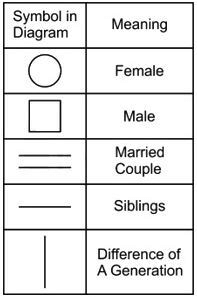
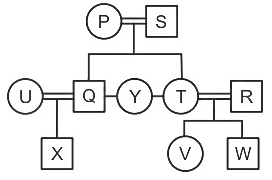

1. S is wife of P.
2. P has only one son.
3. X is grandson of S and son of Q.
4. Q is brother of Y.
5. Y is unmarried.
6. U is daughter-in-law of P.
7. T is sister-in-law of U.
8. R is husband of T.
9. T is sister of Y.
10. V is sister of W and cousin of X.

So, T is sister of Y.
Hence, the correct option is (B).
Direction: Read the information given below and answer the question that follow.10 people A, B, C, D, E, F, G, H, I and J are sitting in two rows facing each other. Half of them are facing north.1. A is sitting in front of E, who is facing north.2. B is sitting in between G and D but neither in front of F nor I.3. F is neighbour of A and H.4. C is 4th left to A and is sitting in front of J.Q. Who sits opposite to I?- a)G
- b)D
- c)A
- d)B
- e)Insufficient information
Correct answer is option 'E'. Can you explain this answer?
Direction: Read the information given below and answer the question that follow.
10 people A, B, C, D, E, F, G, H, I and J are sitting in two rows facing each other. Half of them are facing north.
1. A is sitting in front of E, who is facing north.
2. B is sitting in between G and D but neither in front of F nor I.
3. F is neighbour of A and H.
4. C is 4th left to A and is sitting in front of J.
Q. Who sits opposite to I?
a)
G
b)
D
c)
A
d)
B
e)
Insufficient information

|
Tarun Nambiar answered |
Explanation:
Given Information:
- A is sitting in front of E, who is facing north.
- B is sitting between G and D but neither in front of F nor I.
- F is a neighbour of A and H.
- C is 4th left to A and is sitting in front of J.
Analysis:
- Since A is sitting in front of E and E is facing north, A must be facing south.
- From point 4, C is 4th left to A, so A must be sitting at the end of a row.
- Since B is not in front of F or I, and D is between G and B, B must be sitting opposite to F or I.
- From point 3, F is a neighbour of A and H, so F must be sitting next to A.
- From the above information, we can determine the seating arrangement as follows:
- Row 1 (facing north): E, ?, ?, ?
- Row 2 (facing south): A, F, H, C, J
Answer:
Since there is not enough information given to determine who sits opposite to I, the answer is Insufficient information.
Given Information:
- A is sitting in front of E, who is facing north.
- B is sitting between G and D but neither in front of F nor I.
- F is a neighbour of A and H.
- C is 4th left to A and is sitting in front of J.
Analysis:
- Since A is sitting in front of E and E is facing north, A must be facing south.
- From point 4, C is 4th left to A, so A must be sitting at the end of a row.
- Since B is not in front of F or I, and D is between G and B, B must be sitting opposite to F or I.
- From point 3, F is a neighbour of A and H, so F must be sitting next to A.
- From the above information, we can determine the seating arrangement as follows:
- Row 1 (facing north): E, ?, ?, ?
- Row 2 (facing south): A, F, H, C, J
Answer:
Since there is not enough information given to determine who sits opposite to I, the answer is Insufficient information.
Study the following information carefully and answer the questions given below.874 526 954 218 378 682Q. If all the digits are arranged in ascending order within the number, then which of the following number is the third-highest number?- a)954
- b)378
- c)682
- d)526
- e)None of these
Correct answer is option 'B'. Can you explain this answer?
Study the following information carefully and answer the questions given below.
874 526 954 218 378 682
Q. If all the digits are arranged in ascending order within the number, then which of the following number is the third-highest number?
a)
954
b)
378
c)
682
d)
526
e)
None of these

|
Tarun Modi answered |
Mujhe smjh nhi aa rha iska ansr kya hona cahiye please explain
If the letters of the word ‘RADIOCHEMIST’ are to be arranged in reversed alphabetical order from right to the left end then the position of how many letters will remain unchanged?- a)More than three
- b)Two
- c)One
- d)Zero
- e)Three
Correct answer is option 'E'. Can you explain this answer?
If the letters of the word ‘RADIOCHEMIST’ are to be arranged in reversed alphabetical order from right to the left end then the position of how many letters will remain unchanged?
a)
More than three
b)
Two
c)
One
d)
Zero
e)
Three
|
|
Kabir Verma answered |
The given word
RADIOCHEMIST
After arranging the letters in alphabetical order from right to left end, we get:

Here, we have three such letters whose positions are the same in both words.
Hence, the correct option is (E).
Direction: Study the following information carefully and answer the question given below.Prachi and Rishabh were standing in the middle of the road together on a summer morning. Prachi started walking towards the south and walked 10 m. Then she turned left and walked 5 m and again she turned left and walked for the same distance. Rishabh walked 5 m towards the east and turned right to walk 3 m. Then he turned right to walk 4 m before turning left to walk 2 m more.Q. Rishabh will observe Prachi's and his own shadow towards his which side _______?- a)Left, Right respectively
- b)Right, Left respectively
- c)Front, Front respectively
- d)Back, Front respectively
- e)Right, Right respectively
Correct answer is option 'A'. Can you explain this answer?
Direction: Study the following information carefully and answer the question given below.
Prachi and Rishabh were standing in the middle of the road together on a summer morning. Prachi started walking towards the south and walked 10 m. Then she turned left and walked 5 m and again she turned left and walked for the same distance. Rishabh walked 5 m towards the east and turned right to walk 3 m. Then he turned right to walk 4 m before turning left to walk 2 m more.
Q. Rishabh will observe Prachi's and his own shadow towards his which side _______?
a)
Left, Right respectively
b)
Right, Left respectively
c)
Front, Front respectively
d)
Back, Front respectively
e)
Right, Right respectively

|
Shanaya Dey answered |
Answer:
Given Information:
- Prachi walks 10 m towards the south.
- Prachi then turns left and walks 5 m.
- Prachi turns left again and walks for the same distance.
- Rishabh walks 5 m towards the east.
- Rishabh turns right and walks 3 m.
- Rishabh turns right again and walks 4 m.
- Rishabh turns left and walks 2 m more.
Explanation:
To determine the direction of the shadows, let's analyze the movements of Prachi and Rishabh separately.
Prachi's Movements:
1. Prachi starts by walking 10 m towards the south.
2. Then Prachi turns left and walks 5 m.
3. Prachi turns left again and walks for the same distance.
Prachi's final position is 10 m south and 5 m west from the starting point. Therefore, Prachi will observe her shadow on the left side.
Rishabh's Movements:
1. Rishabh walks 5 m towards the east.
2. Rishabh turns right and walks 3 m.
3. Rishabh turns right again and walks 4 m.
4. Rishabh turns left and walks 2 m more.
Rishabh's final position is 5 m east and 5 m north from the starting point. Therefore, Rishabh will observe his shadow on the right side.
Conclusion:
Based on the above analysis, the answer is option 'A' - Prachi's shadow will be on Rishabh's left side, and Rishabh's shadow will be on Prachi's right side.
Given Information:
- Prachi walks 10 m towards the south.
- Prachi then turns left and walks 5 m.
- Prachi turns left again and walks for the same distance.
- Rishabh walks 5 m towards the east.
- Rishabh turns right and walks 3 m.
- Rishabh turns right again and walks 4 m.
- Rishabh turns left and walks 2 m more.
Explanation:
To determine the direction of the shadows, let's analyze the movements of Prachi and Rishabh separately.
Prachi's Movements:
1. Prachi starts by walking 10 m towards the south.
2. Then Prachi turns left and walks 5 m.
3. Prachi turns left again and walks for the same distance.
Prachi's final position is 10 m south and 5 m west from the starting point. Therefore, Prachi will observe her shadow on the left side.
Rishabh's Movements:
1. Rishabh walks 5 m towards the east.
2. Rishabh turns right and walks 3 m.
3. Rishabh turns right again and walks 4 m.
4. Rishabh turns left and walks 2 m more.
Rishabh's final position is 5 m east and 5 m north from the starting point. Therefore, Rishabh will observe his shadow on the right side.
Conclusion:
Based on the above analysis, the answer is option 'A' - Prachi's shadow will be on Rishabh's left side, and Rishabh's shadow will be on Prachi's right side.
Directions: Read the following information carefully and answer the questions that follow:There are eight employees - P, Q, R, S, T, U, V, and W in a company at different designations - Executive Director, Director, VP, AVP, Senior Manager, Manager, Team Lead, and Associate in descending level of seniority. Q is either the Senior Manager or Manager in the company. P is a senior to V who is senior to U. There are two designations between T and U. R is four posts senior to V. P is junior to at least two members in the company. S is senior to W and an equal number of persons are senior to S and junior to W.Q. What is the designation of V in the company?- a)Team Lead
- b)Associate
- c)Manager
- d)Senior Manager
- e)AVP
Correct answer is option 'C'. Can you explain this answer?
Directions: Read the following information carefully and answer the questions that follow:
There are eight employees - P, Q, R, S, T, U, V, and W in a company at different designations - Executive Director, Director, VP, AVP, Senior Manager, Manager, Team Lead, and Associate in descending level of seniority. Q is either the Senior Manager or Manager in the company. P is a senior to V who is senior to U. There are two designations between T and U. R is four posts senior to V. P is junior to at least two members in the company. S is senior to W and an equal number of persons are senior to S and junior to W.
Q. What is the designation of V in the company?
a)
Team Lead
b)
Associate
c)
Manager
d)
Senior Manager
e)
AVP

|
Mansi Mishra answered |
Understanding the Hierarchy
To determine V's designation, we need to analyze the information provided step by step.
Employees and Their Designations
- There are eight designations in the company, arranged in descending order of seniority:
- Executive Director
- Director
- VP
- AVP
- Senior Manager
- Manager
- Team Lead
- Associate
Key Information
- Q is either the Senior Manager or Manager.
- P is senior to V, who is senior to U.
- There are two designations between T and U.
- R is four posts senior to V.
- P is junior to at least two members in the company.
- S is senior to W, with an equal number of persons senior to S and junior to W.
Breaking Down the Information
1. Q's Position: Since Q can be either Senior Manager or Manager, we will keep this in mind.
2. P, V, and U's Relationship: P > V > U indicates P is senior to V, and V is senior to U.
3. R's Seniority: R is four posts senior to V, which places R at least at the AVP level if V is at the Associate level.
4. P's Position: Since P is junior to at least two members, P cannot be at the top two levels.
5. S and W's Relationship: S is senior to W, and the number of people senior to S equals those junior to W, indicating a balanced hierarchy.
Conclusion for V's Designation
Based on the deductions:
- If V is the Manager, then R must be the VP, and P can be the Senior Manager.
- If V were to be the Senior Manager, it would contradict R being four posts senior.
Thus, the only feasible position for V, fitting all criteria, is Manager (option C).
To determine V's designation, we need to analyze the information provided step by step.
Employees and Their Designations
- There are eight designations in the company, arranged in descending order of seniority:
- Executive Director
- Director
- VP
- AVP
- Senior Manager
- Manager
- Team Lead
- Associate
Key Information
- Q is either the Senior Manager or Manager.
- P is senior to V, who is senior to U.
- There are two designations between T and U.
- R is four posts senior to V.
- P is junior to at least two members in the company.
- S is senior to W, with an equal number of persons senior to S and junior to W.
Breaking Down the Information
1. Q's Position: Since Q can be either Senior Manager or Manager, we will keep this in mind.
2. P, V, and U's Relationship: P > V > U indicates P is senior to V, and V is senior to U.
3. R's Seniority: R is four posts senior to V, which places R at least at the AVP level if V is at the Associate level.
4. P's Position: Since P is junior to at least two members, P cannot be at the top two levels.
5. S and W's Relationship: S is senior to W, and the number of people senior to S equals those junior to W, indicating a balanced hierarchy.
Conclusion for V's Designation
Based on the deductions:
- If V is the Manager, then R must be the VP, and P can be the Senior Manager.
- If V were to be the Senior Manager, it would contradict R being four posts senior.
Thus, the only feasible position for V, fitting all criteria, is Manager (option C).
Direction: In the question below are given three statements followed by three conclusions numbered I, II, and III. You have to take the given statements to be true even if they seem to be at variance with commonly known facts. Read all the conclusions and then decide which of the given conclusions logically follows from the given statements disregarding commonly known facts.Statements:I. Only a few leaves are holidays.II. Few trips are funny.III. No funny is holiday.Conclusions:I. Some leaves are not holiday.II. Some trips are not holiday.III. Some trips are holiday.- a)Either conclusion II or III follows
- b)Both conclusions I and II follow
- c)Only conclusion I follows
- d)Neither conclusion I nor III follows
- e)All follows
Correct answer is option 'B'. Can you explain this answer?
Direction: In the question below are given three statements followed by three conclusions numbered I, II, and III. You have to take the given statements to be true even if they seem to be at variance with commonly known facts. Read all the conclusions and then decide which of the given conclusions logically follows from the given statements disregarding commonly known facts.
Statements:
I. Only a few leaves are holidays.
II. Few trips are funny.
III. No funny is holiday.
Conclusions:
I. Some leaves are not holiday.
II. Some trips are not holiday.
III. Some trips are holiday.
a)
Either conclusion II or III follows
b)
Both conclusions I and II follow
c)
Only conclusion I follows
d)
Neither conclusion I nor III follows
e)
All follows

|
Physics Classes answered |
The least possible Venn diagram for the given statements is as follows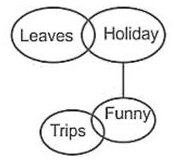

I. Some leaves are not holiday→ True (It is definite)
II. Some trips are not holiday → True (the part of trips which is funny is not holiday)
III. Some trips are holiday → False (It can be possible, but it is not definite)
So, both conclusions I and II follow.
Hence, the correct option is (B).
Study the following information carefully and answer the questions given below.In a certain code language,“District Demanded Argument Society” is written as “vh tm hn fz”“Ratify District Policy Shifted” is written as “bs vf np hn”“Demanded Rupture Tenure Ratify” is written as “dh fz np hm”“Shifted Managed Rhetoric Rupture” is written as “vf mh gh dh”Q. Which of the following may be the code for the phrase “Managed District Policy” in the given code language?- a)tm vf bs
- b)vf mh np
- c)fk bs gh
- d)mh hn gh
- e)bs gh hn
Correct answer is option 'E'. Can you explain this answer?
Study the following information carefully and answer the questions given below.
In a certain code language,
“District Demanded Argument Society” is written as “vh tm hn fz”
“Ratify District Policy Shifted” is written as “bs vf np hn”
“Demanded Rupture Tenure Ratify” is written as “dh fz np hm”
“Shifted Managed Rhetoric Rupture” is written as “vf mh gh dh”
Q. Which of the following may be the code for the phrase “Managed District Policy” in the given code language?
a)
tm vf bs
b)
vf mh np
c)
fk bs gh
d)
mh hn gh
e)
bs gh hn
|
|
Nikita Singh answered |
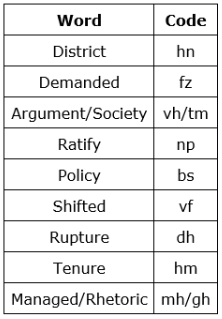
Study the following information carefully and answer the questions given below.Eight persons P, Q, R, S, T, U, V and W are sitting around a circular table facing inside the centre of the table, but not necessarily in the same order.Only one person sits Q and R who sits third to the left of U. U sits second to the right of W and sits adjacent to S who doesn’t sit opposite to Q. P sits adjacent to both T and V who doesn’t sit adjacent to R.Q. Who among the following person sits opposite to P?- a)V
- b)Q
- c)T
- d)S
- e)None of these
Correct answer is option 'B'. Can you explain this answer?
Study the following information carefully and answer the questions given below.
Eight persons P, Q, R, S, T, U, V and W are sitting around a circular table facing inside the centre of the table, but not necessarily in the same order.
Only one person sits Q and R who sits third to the left of U. U sits second to the right of W and sits adjacent to S who doesn’t sit opposite to Q. P sits adjacent to both T and V who doesn’t sit adjacent to R.
Q. Who among the following person sits opposite to P?
a)
V
b)
Q
c)
T
d)
S
e)
None of these
|
|
Nikita Singh answered |
Final arrangement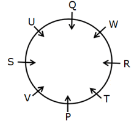
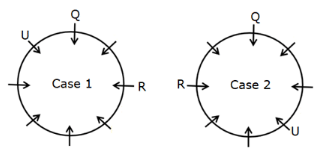
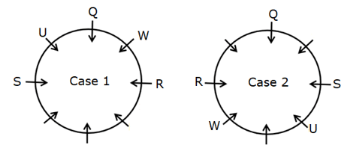
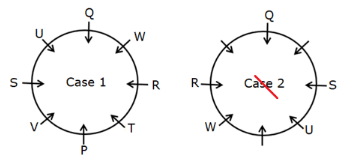

We have,
- Only one person sits Q and R who sits third to the left of U.
From the above condition, there are two possibilities

Again we have,
- U sits second to the right of W and sits adjacent to S who doesn’t sit opposite to Q.

Again we have,
- P sits adjacent to both T and V who doesn’t sit adjacent to R.
So Case 2 gets eliminated, hence Case1 showsthe final arrangement

A rectangular bed sheet has an area of 120 sq. m and the perimeter of the bedsheet is 46 m. Find the length of the diagonal of the bedsheet.- a)15 m
- b)14 mm
- c)17 m
- d)16 m
- e)None of the above
Correct answer is option 'C'. Can you explain this answer?
A rectangular bed sheet has an area of 120 sq. m and the perimeter of the bedsheet is 46 m. Find the length of the diagonal of the bedsheet.
a)
15 m
b)
14 mm
c)
17 m
d)
16 m
e)
None of the above

|
Maya Kaur answered |
To find the length of the diagonal of the bedsheet, we can use the Pythagorean theorem.
Let's assume the length of the bedsheet is 'l' and the width is 'w'.
Given that the area of the bedsheet is 120 sq. m, we can write the equation:
l * w = 120
We are also given that the perimeter of the bedsheet is 46 m. Since the perimeter of a rectangle is given by the formula:
2(l + w), we can write the equation:
2(l + w) = 46
Now we have a system of two equations with two variables. We can solve this system to find the values of 'l' and 'w'.
Solving the first equation for 'w', we get:
w = 120 / l
Substituting this value of 'w' into the second equation, we get:
2(l + 120 / l) = 46
Multiplying both sides by 'l' to eliminate the fraction, we get:
2l^2 + 240 = 46l
Rearranging the equation, we get a quadratic equation:
2l^2 - 46l + 240 = 0
We can solve this quadratic equation by factoring or using the quadratic formula. Factoring the equation, we get:
(l - 6)(2l - 40) = 0
Setting each factor equal to zero, we get two possible values for 'l':
l - 6 = 0 or 2l - 40 = 0
Solving these equations, we get:
l = 6 or l = 20
Since the length cannot be 6 m (as it would result in a width of 20 m, which is greater than the perimeter), we can conclude that the length of the bedsheet is 20 m.
Now, we can use the Pythagorean theorem to find the length of the diagonal. In a rectangle, the diagonal, length, and width form a right triangle.
Using the formula:
diagonal^2 = length^2 + width^2
We can substitute the values:
diagonal^2 = 20^2 + 120^2
diagonal^2 = 400 + 14400
diagonal^2 = 14800
Taking the square root of both sides, we get:
diagonal ≈ 121.60 m
Rounding to the nearest meter, the length of the diagonal is approximately 122 m, which is not an option given in the answer choices.
Therefore, none of the provided answer choices are correct.
Let's assume the length of the bedsheet is 'l' and the width is 'w'.
Given that the area of the bedsheet is 120 sq. m, we can write the equation:
l * w = 120
We are also given that the perimeter of the bedsheet is 46 m. Since the perimeter of a rectangle is given by the formula:
2(l + w), we can write the equation:
2(l + w) = 46
Now we have a system of two equations with two variables. We can solve this system to find the values of 'l' and 'w'.
Solving the first equation for 'w', we get:
w = 120 / l
Substituting this value of 'w' into the second equation, we get:
2(l + 120 / l) = 46
Multiplying both sides by 'l' to eliminate the fraction, we get:
2l^2 + 240 = 46l
Rearranging the equation, we get a quadratic equation:
2l^2 - 46l + 240 = 0
We can solve this quadratic equation by factoring or using the quadratic formula. Factoring the equation, we get:
(l - 6)(2l - 40) = 0
Setting each factor equal to zero, we get two possible values for 'l':
l - 6 = 0 or 2l - 40 = 0
Solving these equations, we get:
l = 6 or l = 20
Since the length cannot be 6 m (as it would result in a width of 20 m, which is greater than the perimeter), we can conclude that the length of the bedsheet is 20 m.
Now, we can use the Pythagorean theorem to find the length of the diagonal. In a rectangle, the diagonal, length, and width form a right triangle.
Using the formula:
diagonal^2 = length^2 + width^2
We can substitute the values:
diagonal^2 = 20^2 + 120^2
diagonal^2 = 400 + 14400
diagonal^2 = 14800
Taking the square root of both sides, we get:
diagonal ≈ 121.60 m
Rounding to the nearest meter, the length of the diagonal is approximately 122 m, which is not an option given in the answer choices.
Therefore, none of the provided answer choices are correct.
Direction: Study the given information to answer the following question.There are 10 cities A, B, Z, Y, K, T, R, J, M, and P in a state. City A is 10 km to the north of city K which is 10 km to the west of city M. City J is 5 km to the south of city M and city R is 5 km to the west of city J. City T is 5 km to the south of city K. City B is 15 km to the north of city M and city Y is 10 km to the south of city P which is 5 km to the south of city Z which is 10 km to the east of city B.Q. Find the direction of city M with respect to city Z.- a)South
- b)South-east
- c)South-west
- d)North-east
- e)West
Correct answer is option 'C'. Can you explain this answer?
Direction: Study the given information to answer the following question.
There are 10 cities A, B, Z, Y, K, T, R, J, M, and P in a state. City A is 10 km to the north of city K which is 10 km to the west of city M. City J is 5 km to the south of city M and city R is 5 km to the west of city J. City T is 5 km to the south of city K. City B is 15 km to the north of city M and city Y is 10 km to the south of city P which is 5 km to the south of city Z which is 10 km to the east of city B.
Q. Find the direction of city M with respect to city Z.
a)
South
b)
South-east
c)
South-west
d)
North-east
e)
West

|
Aditya Ghoshal answered |
Direction of city M with respect to city Z:
To determine the direction of city M with respect to city Z, we need to analyze the given information and the relative positions of the cities.
Step 1: Analyze the given information
- City A is 10 km to the north of city K.
- City K is 10 km to the west of city M.
- City J is 5 km to the south of city M.
- City R is 5 km to the west of city J.
- City T is 5 km to the south of city K.
- City B is 15 km to the north of city M.
- City Y is 10 km to the south of city P.
- City P is 5 km to the south of city Z.
- City Z is 10 km to the east of city B.
Step 2: Determine the relative positions of city M and city Z
- City K is located to the west of city M.
- City P is located to the north of city Z.
- City Z is located to the east of city B.
Based on the given information, we can conclude that city M is located between city K and city P, and city Z is located to the east of city B.
Step 3: Determine the direction of city M with respect to city Z
- City B is located to the north of city M.
- City Z is located to the east of city B.
Since city M is located north of city B and city Z is located east of city B, we can determine that city M is located in the southwest direction with respect to city Z.
Therefore, the correct answer is option C) South-west.
To determine the direction of city M with respect to city Z, we need to analyze the given information and the relative positions of the cities.
Step 1: Analyze the given information
- City A is 10 km to the north of city K.
- City K is 10 km to the west of city M.
- City J is 5 km to the south of city M.
- City R is 5 km to the west of city J.
- City T is 5 km to the south of city K.
- City B is 15 km to the north of city M.
- City Y is 10 km to the south of city P.
- City P is 5 km to the south of city Z.
- City Z is 10 km to the east of city B.
Step 2: Determine the relative positions of city M and city Z
- City K is located to the west of city M.
- City P is located to the north of city Z.
- City Z is located to the east of city B.
Based on the given information, we can conclude that city M is located between city K and city P, and city Z is located to the east of city B.
Step 3: Determine the direction of city M with respect to city Z
- City B is located to the north of city M.
- City Z is located to the east of city B.
Since city M is located north of city B and city Z is located east of city B, we can determine that city M is located in the southwest direction with respect to city Z.
Therefore, the correct answer is option C) South-west.
Study the following information carefully and answer the questions given below.Eight persons P, Q, R, S, T, U, V and W are sitting around a circular table facing inside the centre of the table, but not necessarily in the same order.Only one person sits Q and R who sits third to the left of U. U sits second to the right of W and sits adjacent to S who doesn’t sit opposite to Q. P sits adjacent to both T and V who doesn’t sit adjacent to R.Q. Who among the following person sits immediate left of V?- a)The one who sits opposite to U
- b)R
- c)The one who sits second to the right of Q
- d)W
- e)None of these
Correct answer is option 'C'. Can you explain this answer?
Study the following information carefully and answer the questions given below.
Eight persons P, Q, R, S, T, U, V and W are sitting around a circular table facing inside the centre of the table, but not necessarily in the same order.
Only one person sits Q and R who sits third to the left of U. U sits second to the right of W and sits adjacent to S who doesn’t sit opposite to Q. P sits adjacent to both T and V who doesn’t sit adjacent to R.
Q. Who among the following person sits immediate left of V?
a)
The one who sits opposite to U
b)
R
c)
The one who sits second to the right of Q
d)
W
e)
None of these

|
Shanaya Dey answered |
Given Information:
- There are eight persons - P, Q, R, S, T, U, V, and W.
- They are sitting around a circular table facing the inside of the table.
- Q and R sit third to the left of U.
- U sits second to the right of W and adjacent to S.
- S does not sit opposite to Q.
- P sits adjacent to both T and V.
- V does not sit adjacent to R.
Step-by-Step Solution:
To find out who sits immediately left of V, let's analyze the given information:
1. From the information that Q and R sit third to the left of U, we can determine the possible positions of U, Q, and R:
- If U sits at position 1, then Q will sit at position 5 and R at position 8.
- If U sits at position 2, then Q will sit at position 6 and R at position 1.
2. From the information that U sits second to the right of W and adjacent to S, we can determine the possible positions of U, W, and S:
- If U sits at position 1, then W will sit at position 3 and S at position 2.
- If U sits at position 2, then W will sit at position 4 and S at position 3.
3. From the information that S does not sit opposite to Q, we can conclude that S cannot sit at positions 5 or 6.
4. From the information that P sits adjacent to both T and V and V does not sit adjacent to R, we can determine the possible positions of P, T, and V:
- If P sits at position 1, then T will sit at position 2 and V at position 8.
- If P sits at position 2, then T will sit at position 3 and V at position 1.
- If P sits at position 3, then T will sit at position 4 and V at position 2.
- If P sits at position 4, then T will sit at position 5 and V at position 3.
- If P sits at position 5, then T will sit at position 6 and V at position 4.
- If P sits at position 6, then T will sit at position 7 and V at position 5.
- If P sits at position 7, then T will sit at position 8 and V at position 6.
- If P sits at position 8, then T will sit at position 1 and V at position 7.
5. Combining the above information, we can create the following possibilities:
- U sits at position 1, W at position 3, S at position 2, Q at position 5, R at position 8, P at position 2, T at position 3, and V at position 1.
- U sits at position 1, W at position 3, S at position 2, Q at position 5, R at position 8, P at position 3, T at position 4, and V at position 2.
- U sits at position 2, W at position 4, S at position 3, Q at position
- There are eight persons - P, Q, R, S, T, U, V, and W.
- They are sitting around a circular table facing the inside of the table.
- Q and R sit third to the left of U.
- U sits second to the right of W and adjacent to S.
- S does not sit opposite to Q.
- P sits adjacent to both T and V.
- V does not sit adjacent to R.
Step-by-Step Solution:
To find out who sits immediately left of V, let's analyze the given information:
1. From the information that Q and R sit third to the left of U, we can determine the possible positions of U, Q, and R:
- If U sits at position 1, then Q will sit at position 5 and R at position 8.
- If U sits at position 2, then Q will sit at position 6 and R at position 1.
2. From the information that U sits second to the right of W and adjacent to S, we can determine the possible positions of U, W, and S:
- If U sits at position 1, then W will sit at position 3 and S at position 2.
- If U sits at position 2, then W will sit at position 4 and S at position 3.
3. From the information that S does not sit opposite to Q, we can conclude that S cannot sit at positions 5 or 6.
4. From the information that P sits adjacent to both T and V and V does not sit adjacent to R, we can determine the possible positions of P, T, and V:
- If P sits at position 1, then T will sit at position 2 and V at position 8.
- If P sits at position 2, then T will sit at position 3 and V at position 1.
- If P sits at position 3, then T will sit at position 4 and V at position 2.
- If P sits at position 4, then T will sit at position 5 and V at position 3.
- If P sits at position 5, then T will sit at position 6 and V at position 4.
- If P sits at position 6, then T will sit at position 7 and V at position 5.
- If P sits at position 7, then T will sit at position 8 and V at position 6.
- If P sits at position 8, then T will sit at position 1 and V at position 7.
5. Combining the above information, we can create the following possibilities:
- U sits at position 1, W at position 3, S at position 2, Q at position 5, R at position 8, P at position 2, T at position 3, and V at position 1.
- U sits at position 1, W at position 3, S at position 2, Q at position 5, R at position 8, P at position 3, T at position 4, and V at position 2.
- U sits at position 2, W at position 4, S at position 3, Q at position
Study the following information carefully and answer the questions given below.In a certain code language,“District Demanded Argument Society” is written as “vh tm hn fz”“Ratify District Policy Shifted” is written as “bs vf np hn”“Demanded Rupture Tenure Ratify” is written as “dh fz np hm”“Shifted Managed Rhetoric Rupture” is written as “vf mh gh dh”Q. Which of the following is the code for the word “Rupture” in the given code language?- a)mh
- b)np
- c)dh
- d)fz
- e)None of these
Correct answer is option 'C'. Can you explain this answer?
Study the following information carefully and answer the questions given below.
In a certain code language,
“District Demanded Argument Society” is written as “vh tm hn fz”
“Ratify District Policy Shifted” is written as “bs vf np hn”
“Demanded Rupture Tenure Ratify” is written as “dh fz np hm”
“Shifted Managed Rhetoric Rupture” is written as “vf mh gh dh”
Q. Which of the following is the code for the word “Rupture” in the given code language?
a)
mh
b)
np
c)
dh
d)
fz
e)
None of these
|
|
Ritika Choudhury answered |
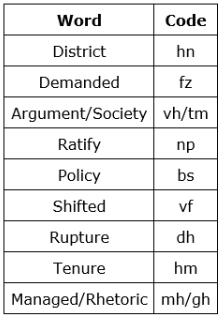
Direction: What should come in place of the question mark '?' in the following number series?Q. 79, 108, 139, 176, 217, ?- a)301
- b)260
- c)264
- d)273
- e)274
Correct answer is option 'B'. Can you explain this answer?
Direction: What should come in place of the question mark '?' in the following number series?
Q. 79, 108, 139, 176, 217, ?
a)
301
b)
260
c)
264
d)
273
e)
274
|
|
Kabir Verma answered |
The pattern is as follows
Logic: Addition of Prime numbers
79 + 29 = 108
108 + 31 = 139
139 + 37 = 176
176 + 41 = 217
217 + 43 = 260
∴ The value of ? is 260.
Hence, the correct option is (B).
Study the following information carefully and answer the below questions.
In a certain code language
‘Indian Company Work Environment’ means ‘mj xt rs ae’,
‘Company Leadership skill Employee’ means ‘xt fm qp vo’,
‘Well Being Work Employee’ means ‘lm nt vo rs’,
‘Indian Skill Growth Develop’ means ‘mj qp wg mp’
Q. What does "ae" represent in a code language?
- a)Work
- b)Environment
- c)Company
- d)Indian
- e)None of these
Correct answer is option 'B'. Can you explain this answer?
Study the following information carefully and answer the below questions.
In a certain code language
‘Indian Company Work Environment’ means ‘mj xt rs ae’,
‘Company Leadership skill Employee’ means ‘xt fm qp vo’,
‘Well Being Work Employee’ means ‘lm nt vo rs’,
‘Indian Skill Growth Develop’ means ‘mj qp wg mp’
Q. What does "ae" represent in a code language?
a)
Work
b)
Environment
c)
Company
d)
Indian
e)
None of these

|
Swati Datta answered |
1. "kob" is coded as "3018"
2. "pam" is coded as "4052"
3. "kil" is coded as "2084"
1. What is the code for "map"?
2. What is the code for "bob"?
3. What is the code for "lik"?
2. "pam" is coded as "4052"
3. "kil" is coded as "2084"
1. What is the code for "map"?
2. What is the code for "bob"?
3. What is the code for "lik"?
Direction: Study the following information carefully to answer the given questions:V @ 2 3 K 6 # P % S 1 7 & * G I ©️ 5 9 8 $ Y D A € 4 ¥ Z B OWhich of the following is the seventh to the left of the sixteenth element from the right end of the above arrangement?- a)@
- b)€
- c)P
- d)1
- e)I
Correct answer is option 'C'. Can you explain this answer?
Direction: Study the following information carefully to answer the given questions:
V @ 2 3 K 6 # P % S 1 7 & * G I ©️ 5 9 8 $ Y D A € 4 ¥ Z B O
Which of the following is the seventh to the left of the sixteenth element from the right end of the above arrangement?
a)
@
b)
€
c)
P
d)
1
e)
I

|
Prashanth Choudhary answered |
B Answer:
Explanation:
- **Identifying the elements:**
- Counting from the right end, the sixteenth element is 'P'.
- Now, counting seven elements to the left of 'P', we reach '7'.
- **Finding the Seventh to the Left of the Sixteenth Element:**
- So, the seventh to the left of the sixteenth element from the right end of the arrangement is '7'.
Therefore, the correct answer is option 'C' which is 'P'.
Explanation:
- **Identifying the elements:**
- Counting from the right end, the sixteenth element is 'P'.
- Now, counting seven elements to the left of 'P', we reach '7'.
- **Finding the Seventh to the Left of the Sixteenth Element:**
- So, the seventh to the left of the sixteenth element from the right end of the arrangement is '7'.
Therefore, the correct answer is option 'C' which is 'P'.
A shopkeeper bought 15 coffee markers for Rs.31500 and he also spends Rs.500 each for its repair. If he sold 15 coffee markers for Rs.46800, then find the profit percentage?- a)40%
- b)10%
- c)15%
- d)20%
- e)None of these
Correct answer is option 'D'. Can you explain this answer?
A shopkeeper bought 15 coffee markers for Rs.31500 and he also spends Rs.500 each for its repair. If he sold 15 coffee markers for Rs.46800, then find the profit percentage?
a)
40%
b)
10%
c)
15%
d)
20%
e)
None of these

|
Rajdeep Verma answered |
Calculation of Profit Percentage:
1. Cost Price (CP) of 1 coffee maker:
Total cost of 15 coffee makers = Rs. 31500
Cost of 1 coffee maker = Rs. 31500 / 15 = Rs. 2100
2. Cost Price (CP) of 1 coffee maker after repair:
Cost of repair for 1 coffee maker = Rs. 500
Total cost after repair = Rs. 2100 + Rs. 500 = Rs. 2600
3. Total Cost Price (CP) for 15 coffee makers:
Total CP for 15 coffee makers = Rs. 2600 x 15 = Rs. 39000
4. Selling Price (SP) of 15 coffee makers:
Total selling price for 15 coffee makers = Rs. 46800
5. Profit:
Profit = SP - CP
Profit = Rs. 46800 - Rs. 39000 = Rs. 7800
6. Profit Percentage:
Profit Percentage = (Profit / CP) x 100
Profit Percentage = (7800 / 39000) x 100 = 20%
Therefore, the profit percentage is 20% for the shopkeeper. Hence, option 'D' is the correct answer.
Study the following information to answer the given question.Point P is 9 m towards the East of point Q. Point R is 5 m towards the South of point P. Point S is 3 m towards the West of point R. Point T is 5 m towards the North of point S. Point V is 7 m towards the South of point S.If a person walks in a straight line for 8 m towards West from point R, which of the following points would he cross the first?- a)V
- b)Q
- c)T
- d)S
- e)Cannot be determined
Correct answer is option 'D'. Can you explain this answer?
Study the following information to answer the given question.
Point P is 9 m towards the East of point Q. Point R is 5 m towards the South of point P. Point S is 3 m towards the West of point R. Point T is 5 m towards the North of point S. Point V is 7 m towards the South of point S.If a person walks in a straight line for 8 m towards West from point R, which of the following points would he cross the first?
a)
V
b)
Q
c)
T
d)
S
e)
Cannot be determined
|
|
Dia Mehta answered |
Point P is 9 m towards the East of point Q. Point R is 5 m towards the South of point P. Point S is 3 m towards the West of point R. Point T is 5 m towards the North of point S. Point V is 7 m towards the South of point S.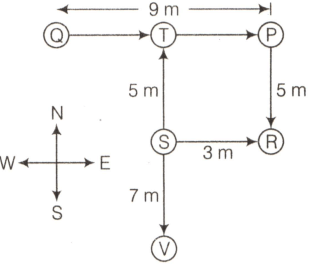

From the diagram, we can observe that if the person will walk in a straight line for 8 m towards West from point R then he will cross the point S first.
Directions: Read the following information carefully and answer the questions that follow:There are eight employees - P, Q, R, S, T, U, V, and W in a company at different designations - Executive Director, Director, VP, AVP, Senior Manager, Manager, Team Lead, and Associate in descending level of seniority. Q is either the Senior Manager or Manager in the company. P is a senior to V who is senior to U. There are two designations between T and U. R is four posts senior to V. P is junior to at least two members in the company. S is senior to W and an equal number of persons are senior to S and junior to W.Q. Who is the VP in the company?- a)T
- b)Q
- c)U
- d)P
- e)Cannot be determined
Correct answer is option 'D'. Can you explain this answer?
Directions: Read the following information carefully and answer the questions that follow:
There are eight employees - P, Q, R, S, T, U, V, and W in a company at different designations - Executive Director, Director, VP, AVP, Senior Manager, Manager, Team Lead, and Associate in descending level of seniority. Q is either the Senior Manager or Manager in the company. P is a senior to V who is senior to U. There are two designations between T and U. R is four posts senior to V. P is junior to at least two members in the company. S is senior to W and an equal number of persons are senior to S and junior to W.
Q. Who is the VP in the company?
a)
T
b)
Q
c)
U
d)
P
e)
Cannot be determined
|
|
Rahul Mehta answered |
Eight Employees: P, Q, R, S, T, U, V and W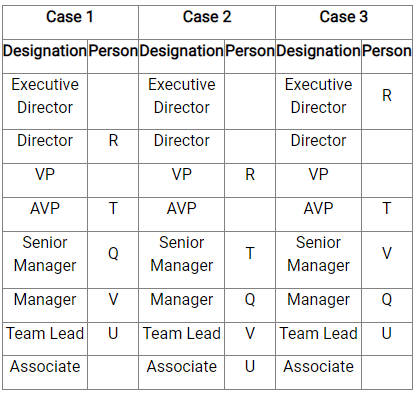
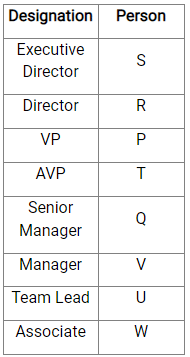
Designations: Executive Director, Director, VP, AVP, Senior Manager, Manager, Team Lead, and Associate
1) Q is either the Senior Manager or Manager in the company.
2) P is a senior to V who is senior to U.
3) There are two designations between T and U.
4) R is four posts senior to V.

5) P is junior to at least two members in the company.
6) S is senior to W and an equal number of persons are senior to S and junior to W.
As the above conditions are not satisfied in case 2 and case 3, they will get canceled.

So, P is the VP of the company.
Hence, the correct option is (D).
Study the following statements and then decide which of the given conclusions logically follows from the given statements disregarding the commonly known facts.Q. Statements:Some Peaks are TrekNo Trek is CheckAll Checks are PlankConclusions:I). Some Planks are not TrekII). All Peaks being Plank is a possibility- a)Only conclusion I follows
- b)Only conclusion II follows
- c)Both conclusions I and II follow
- d)Neither conclusion I nor II follows
- e)Either conclusion I or II follows
Correct answer is option 'C'. Can you explain this answer?
Study the following statements and then decide which of the given conclusions logically follows from the given statements disregarding the commonly known facts.
Q. Statements:
Some Peaks are Trek
No Trek is Check
All Checks are Plank
Conclusions:
I). Some Planks are not Trek
II). All Peaks being Plank is a possibility
a)
Only conclusion I follows
b)
Only conclusion II follows
c)
Both conclusions I and II follow
d)
Neither conclusion I nor II follows
e)
Either conclusion I or II follows

|
Devanshi Sarkar answered |
Statements:
Some Peaks are Trek
No Trek is Check
All Checks are Plank
Conclusions:
I) Some Planks are not Trek
II) All Peaks being Plank is a possibility
Explanation:
1. Some Planks are not Trek:
- From the given statements, we can see that no Trek is a Check and all Checks are Plank.
- This means that some Planks are not Trek, as there is no overlap between Trek and Check.
- Therefore, conclusion I follows.
2. All Peaks being Plank is a possibility:
- Since some Peaks are Trek and all Checks are Plank, there is a possibility that all Peaks could be Plank indirectly through the connection of Trek and Plank.
- This possibility exists based on the given statements.
- Therefore, conclusion II also follows.
Therefore, both conclusions I and II follow from the given statements.
Some Peaks are Trek
No Trek is Check
All Checks are Plank
Conclusions:
I) Some Planks are not Trek
II) All Peaks being Plank is a possibility
Explanation:
1. Some Planks are not Trek:
- From the given statements, we can see that no Trek is a Check and all Checks are Plank.
- This means that some Planks are not Trek, as there is no overlap between Trek and Check.
- Therefore, conclusion I follows.
2. All Peaks being Plank is a possibility:
- Since some Peaks are Trek and all Checks are Plank, there is a possibility that all Peaks could be Plank indirectly through the connection of Trek and Plank.
- This possibility exists based on the given statements.
- Therefore, conclusion II also follows.
Therefore, both conclusions I and II follow from the given statements.
The monthly stipend paid to each of the student selected for an internship at a company was Rs. 4000. The monthly stipend paid to boys and girls were Rs. 4500 and Rs. 3800 respectively. Determine the ratio in which the number of boys and girls selected for the internship at the company.- a)42 ∶ 84
- b)44 ∶ 110
- c)36 ∶ 72
- d)39 ∶ 91
- e)None of these
Correct answer is option 'B'. Can you explain this answer?
The monthly stipend paid to each of the student selected for an internship at a company was Rs. 4000. The monthly stipend paid to boys and girls were Rs. 4500 and Rs. 3800 respectively. Determine the ratio in which the number of boys and girls selected for the internship at the company.
a)
42 ∶ 84
b)
44 ∶ 110
c)
36 ∶ 72
d)
39 ∶ 91
e)
None of these

|
Shraddha Chopra answered |
Given Data:
- Stipend for boys: Rs. 4500
- Stipend for girls: Rs. 3800
- Stipend for each student: Rs. 4000
Solution:
Let the number of boys selected be 'x' and the number of girls selected be 'y'.
- Total stipend for boys = 4500x
- Total stipend for girls = 3800y
- Total stipend for all students = 4000(x + y)
Since the total stipend for all students is the same, we can write the equation as:
4500x + 3800y = 4000(x + y)
Solving the above equation, we get:
500x = 200y
x = 2y
Therefore, the ratio of boys to girls selected for the internship is 2:1.
Hence, the correct answer is option B) 44:110.
- Stipend for boys: Rs. 4500
- Stipend for girls: Rs. 3800
- Stipend for each student: Rs. 4000
Solution:
Let the number of boys selected be 'x' and the number of girls selected be 'y'.
- Total stipend for boys = 4500x
- Total stipend for girls = 3800y
- Total stipend for all students = 4000(x + y)
Since the total stipend for all students is the same, we can write the equation as:
4500x + 3800y = 4000(x + y)
Solving the above equation, we get:
500x = 200y
x = 2y
Therefore, the ratio of boys to girls selected for the internship is 2:1.
Hence, the correct answer is option B) 44:110.
A car covers 448 km in 8 hours and the speed of the car is equal to 140% of the speed of the bike. Find the sum of the time taken by the car to cover 280 km and the time taken by the bike to cover 120 km?- a)7 hours
- b)5 hours
- c)8 hours
- d)10 hours
- e)None of these
Correct answer is option 'C'. Can you explain this answer?
A car covers 448 km in 8 hours and the speed of the car is equal to 140% of the speed of the bike. Find the sum of the time taken by the car to cover 280 km and the time taken by the bike to cover 120 km?
a)
7 hours
b)
5 hours
c)
8 hours
d)
10 hours
e)
None of these
|
|
Ritika Choudhury answered |
Let speed of the car = 448/8 = 56 km/hr
Then, speed of the bike = 56 * 100/140 = 40 km/hr
Therefore, sum of the time taken by the car and bike together = 280/56 + 120/40 = 5 + 3 = 8 hours
M is the father of V. V is the sister of X. X is married to R. R is the daughter of P. P is the wife of H.If N is the only child of V, then how is N related to M?- a)Grandfather
- b)Daughter
- c)Son
- d)Cannot be determined
- e)Brother
Correct answer is option 'D'. Can you explain this answer?
M is the father of V. V is the sister of X. X is married to R. R is the daughter of P. P is the wife of H.
If N is the only child of V, then how is N related to M?
a)
Grandfather
b)
Daughter
c)
Son
d)
Cannot be determined
e)
Brother
|
|
Rohan Sengupta answered |
Family tree based on the given information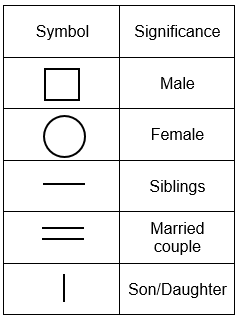
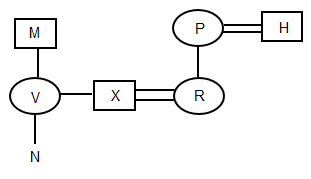

1) M is the father of V.
2) V is the sister of X.
Implies, V is the daughter of M.
3) X is married to R.
4) R is the daughter of P.
Implies, X is the husband of R and the brother of V.
5) P is the wife of H.
Implies, H is the father of R.

Relation of N with respect to M cannot be determined as the gender of N is not known.
Study the following information to answer the given questions.Ten people are sitting in two parallel rows containing five people each, in such a way that there is an equal distance between adjacent persons. In row-1, P, Q, R, S, and T are seated and all of them are facing South. In row-2, A, B, C, D, and E are seated and all of them are facing North. Therefore, in the given sitting arrangement each member seated in a row faces another member of the other row. D sits third to the left of A. P faces immediate neighbour of D. R sits second to the right of P. Only one person sits between Q and S. B and E are immediate neighbours of each other. E does not face P and Q.Q. Which of the following is true regarding B?- a)A and C are immediate neighbours of B
- b)B sits at one of the extreme ends of the line
- c)Q faces B
- d)T is an immediate neighbour of the person facing B
- e)D sits to the immediate left of B
Correct answer is option 'E'. Can you explain this answer?
Study the following information to answer the given questions.
Ten people are sitting in two parallel rows containing five people each, in such a way that there is an equal distance between adjacent persons. In row-1, P, Q, R, S, and T are seated and all of them are facing South. In row-2, A, B, C, D, and E are seated and all of them are facing North. Therefore, in the given sitting arrangement each member seated in a row faces another member of the other row. D sits third to the left of A. P faces immediate neighbour of D. R sits second to the right of P. Only one person sits between Q and S. B and E are immediate neighbours of each other. E does not face P and Q.
Q. Which of the following is true regarding B?
a)
A and C are immediate neighbours of B
b)
B sits at one of the extreme ends of the line
c)
Q faces B
d)
T is an immediate neighbour of the person facing B
e)
D sits to the immediate left of B
|
|
Dia Mehta answered |
According to the given information, in row-1 P, Q, R, S and T are seated and all of them are facing South and in row-2 A, B, C, D and E are seated and all of them are facing North.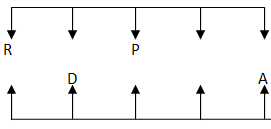
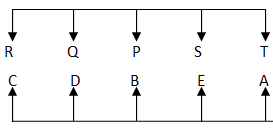
Now, D sits third to the left of A and P faces immediate neighbour of D. R sits second to the right of P.

Also, only one person sits between Q and S. B and E are immediate neighbours of each other. E does not face P and Q.

From the above sitting arrangements, we can observe that D sits to the immediate left of B.
If 2 is subtracted from each even digit of the number “765435821” and 1 is added to each odd digit of the number, then how many digits are repeated more than once in the newly obtained number?- a)One
- b)Two
- c)Three
- d)More than three
- e)None
Correct answer is option 'C'. Can you explain this answer?
If 2 is subtracted from each even digit of the number “765435821” and 1 is added to each odd digit of the number, then how many digits are repeated more than once in the newly obtained number?
a)
One
b)
Two
c)
Three
d)
More than three
e)
None
|
|
Nikita Singh answered |
7 6 5 4 3 5 8 2 1
8 4 6 2 4 6 6 0 2
4, 2, and 6 are repeated more than once.
The average weight of a class is 35 kg and the teacher’s weight is included then the average weight of class is increased by 1 kg. If the weight of the teacher is 56 kg, then find the number of students in the class?- a)22
- b)21
- c)20
- d)24
- e)None of these
Correct answer is option 'C'. Can you explain this answer?
The average weight of a class is 35 kg and the teacher’s weight is included then the average weight of class is increased by 1 kg. If the weight of the teacher is 56 kg, then find the number of students in the class?
a)
22
b)
21
c)
20
d)
24
e)
None of these

|
Navya Chavan answered |
Let's solve the problem step by step:
Given:
- The average weight of the class is 35 kg.
- The teacher's weight is included in this average.
- The weight of the teacher is 56 kg.
- The average weight of the class increases by 1 kg when the teacher's weight is included.
To find:
- The number of students in the class.
Assume:
- The number of students in the class is 'x'.
Finding the total weight of the class without the teacher:
- Since the average weight of the class is 35 kg, the total weight of the class without the teacher would be (35 * x) kg.
Finding the total weight of the class with the teacher:
- Since the average weight of the class increases by 1 kg when the teacher's weight is included, the new average weight of the class is (35 + 1) = 36 kg.
- The total weight of the class with the teacher would be (36 * (x + 1)) kg.
Finding the weight of the teacher:
- The weight of the teacher is given as 56 kg.
Equating the total weights:
- Since the total weight of the class without the teacher is equal to the total weight of the class with the teacher, we can set up the equation as follows:
(35 * x) = (36 * (x + 1)) - 56
Solving the equation:
- Expanding the equation, we get:
35x = 36x + 36 - 56
35x - 36x = -20
-x = -20
Simplifying the equation, we find that:
- Divide both sides by -1:
x = 20
Therefore, the number of students in the class is 20.
Hence, the correct answer is option C: 20.
Given:
- The average weight of the class is 35 kg.
- The teacher's weight is included in this average.
- The weight of the teacher is 56 kg.
- The average weight of the class increases by 1 kg when the teacher's weight is included.
To find:
- The number of students in the class.
Assume:
- The number of students in the class is 'x'.
Finding the total weight of the class without the teacher:
- Since the average weight of the class is 35 kg, the total weight of the class without the teacher would be (35 * x) kg.
Finding the total weight of the class with the teacher:
- Since the average weight of the class increases by 1 kg when the teacher's weight is included, the new average weight of the class is (35 + 1) = 36 kg.
- The total weight of the class with the teacher would be (36 * (x + 1)) kg.
Finding the weight of the teacher:
- The weight of the teacher is given as 56 kg.
Equating the total weights:
- Since the total weight of the class without the teacher is equal to the total weight of the class with the teacher, we can set up the equation as follows:
(35 * x) = (36 * (x + 1)) - 56
Solving the equation:
- Expanding the equation, we get:
35x = 36x + 36 - 56
35x - 36x = -20
-x = -20
Simplifying the equation, we find that:
- Divide both sides by -1:
x = 20
Therefore, the number of students in the class is 20.
Hence, the correct answer is option C: 20.
Age of Umesh will be 4 times the age of Reena in 6 years from today. If ages of Umesh and Mahesh are 7 times and 6 times the age of Reena respectively, what is present age of Umesh?- a)64 years
- b)30 years
- c)48 years
- d)42 years
- e)52 years
Correct answer is option 'D'. Can you explain this answer?
Age of Umesh will be 4 times the age of Reena in 6 years from today. If ages of Umesh and Mahesh are 7 times and 6 times the age of Reena respectively, what is present age of Umesh?
a)
64 years
b)
30 years
c)
48 years
d)
42 years
e)
52 years

|
Janani Kulkarni answered |
To solve this problem, we can start by setting up equations for the given information. Let's assign variables to the ages of Umesh, Reena, and Mahesh.
Let's say the present age of Reena is R years.
According to the given information:
The present age of Umesh is 7 times the age of Reena, so the present age of Umesh is 7R years.
The present age of Mahesh is 6 times the age of Reena, so the present age of Mahesh is 6R years.
Now, let's consider the information given about the future age of Umesh.
The age of Umesh in 6 years will be 4 times the age of Reena in 6 years.
In 6 years, Reena's age will be R + 6 years.
So, Umesh's age in 6 years will be 4 times (R + 6).
Setting up the equation:
7R + 6 = 4(R + 6)
Solving the equation:
7R + 6 = 4R + 24
7R - 4R = 24 - 6
3R = 18
R = 6
So, the present age of Reena is 6 years.
Now, we can find the present age of Umesh:
Umesh's present age = 7R = 7 * 6 = 42 years.
Therefore, the present age of Umesh is 42 years. Option D is correct.
Let's say the present age of Reena is R years.
According to the given information:
The present age of Umesh is 7 times the age of Reena, so the present age of Umesh is 7R years.
The present age of Mahesh is 6 times the age of Reena, so the present age of Mahesh is 6R years.
Now, let's consider the information given about the future age of Umesh.
The age of Umesh in 6 years will be 4 times the age of Reena in 6 years.
In 6 years, Reena's age will be R + 6 years.
So, Umesh's age in 6 years will be 4 times (R + 6).
Setting up the equation:
7R + 6 = 4(R + 6)
Solving the equation:
7R + 6 = 4R + 24
7R - 4R = 24 - 6
3R = 18
R = 6
So, the present age of Reena is 6 years.
Now, we can find the present age of Umesh:
Umesh's present age = 7R = 7 * 6 = 42 years.
Therefore, the present age of Umesh is 42 years. Option D is correct.
Study the following information carefully and answer the questions given below.Eight persons H, I, J, K, L, M, N and O are staying in two different flats viz., Flat A and Flat B of a four storey building, but not necessarily in the same order. Flat A is to the west of Flat B. The lowermost floor is numbered as 1 and the floor immediately above is numbered as 2 and so on.I stays three floors above K and both stay in different flats. L who doesn’t stay on the same floor as K stays to the southwest of N. H stays to the west of N. J stays above M and neither of them stays in the same flat as O. O doesn’t stay on the first floor.Q. Who among the following person stays to the east of L?- a)I
- b)The one who stays immediate north of J
- c)M
- d)The one who stays immediate northeast of K
- e)None of these
Correct answer is option 'D'. Can you explain this answer?
Study the following information carefully and answer the questions given below.
Eight persons H, I, J, K, L, M, N and O are staying in two different flats viz., Flat A and Flat B of a four storey building, but not necessarily in the same order. Flat A is to the west of Flat B. The lowermost floor is numbered as 1 and the floor immediately above is numbered as 2 and so on.
I stays three floors above K and both stay in different flats. L who doesn’t stay on the same floor as K stays to the southwest of N. H stays to the west of N. J stays above M and neither of them stays in the same flat as O. O doesn’t stay on the first floor.
Q. Who among the following person stays to the east of L?
a)
I
b)
The one who stays immediate north of J
c)
M
d)
The one who stays immediate northeast of K
e)
None of these
|
|
Ishan Choudhury answered |
Final arrangement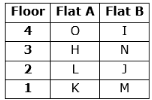
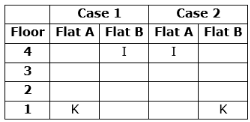
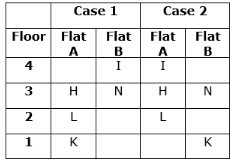
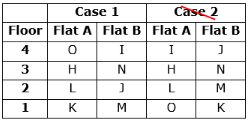

We have,
- I stays three floors above K and both stay in different flats.
From the above condition, there are two possibilities

Again we have,
- L who doesn’t stay on the same floor as K stays to the southwest of N.
- H stays to the west of N.

Again we have,
- J stays above M and neither of them stays in the same flat as O.
- O doesn’t stay on the first floor.
So Case 2 gets eliminated, hence Case1 shows the final arrangement

Directions: Read the following information carefully and answer the questions that follow:There are eight employees - P, Q, R, S, T, U, V, and W in a company at different designations - Executive Director, Director, VP, AVP, Senior Manager, Manager, Team Lead, and Associate in descending level of seniority. Q is either the Senior Manager or Manager in the company. P is a senior to V who is senior to U. There are two designations between T and U. R is four posts senior to V. P is junior to at least two members in the company. S is senior to W and an equal number of persons are senior to S and junior to W.Q. How any persons are senior to T?- a)Three
- b)Four
- c)Two
- d)One
- e)No one
Correct answer is option 'A'. Can you explain this answer?
Directions: Read the following information carefully and answer the questions that follow:
There are eight employees - P, Q, R, S, T, U, V, and W in a company at different designations - Executive Director, Director, VP, AVP, Senior Manager, Manager, Team Lead, and Associate in descending level of seniority. Q is either the Senior Manager or Manager in the company. P is a senior to V who is senior to U. There are two designations between T and U. R is four posts senior to V. P is junior to at least two members in the company. S is senior to W and an equal number of persons are senior to S and junior to W.
Q. How any persons are senior to T?
a)
Three
b)
Four
c)
Two
d)
One
e)
No one
|
|
Ishan Choudhury answered |
Eight Employees: P, Q, R, S, T, U, V and W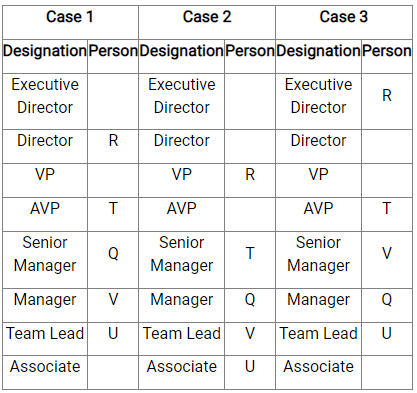
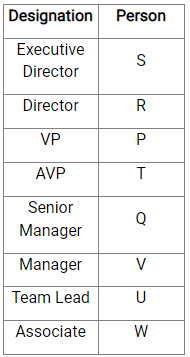
Designations: Executive Director, Director, VP, AVP, Senior Manager, Manager, Team Lead, and Associate
1) Q is either the Senior Manager or Manager in the company.
2) P is a senior to V who is senior to U.
3) There are two designations between T and U.
4) R is four posts senior to V.

5) P is junior to at least two members in the company.
6) S is senior to W and an equal number of persons are senior to S and junior to W.
As the above conditions are not satisfied in case 2 and case 3, they will get canceled.

So, three persons are senior to T.
Hence, the correct option is (A).
In a certain code language, 'pit nae tom' means 'apple is green', 'nae ho tap' means 'green and white' and 'ho tom ka' means 'shirt is white'. Which of the following code word is used for the word 'apple' in this code language?- a)nae
- b)tom
- c)pit
- d)ho
- e)ka
Correct answer is option 'C'. Can you explain this answer?
In a certain code language, 'pit nae tom' means 'apple is green', 'nae ho tap' means 'green and white' and 'ho tom ka' means 'shirt is white'. Which of the following code word is used for the word 'apple' in this code language?
a)
nae
b)
tom
c)
pit
d)
ho
e)
ka
|
|
Kabir Verma answered |
According to the given information,
pit nae tom : apple is green
nae ho tap : green and white
ho tom ka : shirt is white
Here, as 'apple' does not appear in any other statement, except first, and neither does the code word 'pit', therefore the code word for apple is 'pit'.
Direction: Read the following information carefully and answer the question that follow:A, B, C, D, E, F, and H are family members related to each other. A is the father of D who is the brother of F. E is the husband of H. F is the sister of E. B is the son of D and husband of C.Q. How is E related to B?- a)Brother-in-law
- b)Father-in-law
- c)Brother
- d)Uncle
- e)Father
Correct answer is option 'D'. Can you explain this answer?
Direction: Read the following information carefully and answer the question that follow:
A, B, C, D, E, F, and H are family members related to each other. A is the father of D who is the brother of F. E is the husband of H. F is the sister of E. B is the son of D and husband of C.
Q. How is E related to B?
a)
Brother-in-law
b)
Father-in-law
c)
Brother
d)
Uncle
e)
Father

|
Simran Choudhury answered |
How is E related to B?
To determine the relationship between E and B, we need to analyze the given information and the family tree.
Given Information:
- A is the father of D.
- D is the brother of F.
- E is the husband of H.
- F is the sister of E.
- B is the son of D and husband of C.
Family Tree:
A
/ \
D ?
/ \
B F
/
E
\
H
Based on the given information and family tree, we can conclude the following:
1. A is the father of D.
2. D is the brother of F.
3. E is the husband of H.
4. F is the sister of E.
5. B is the son of D and husband of C.
From the family tree, we can see that B and F are siblings since they share the same parent D.
Therefore, E is the brother-in-law of B.
Conclusion:
E is related to B as brother-in-law.
To determine the relationship between E and B, we need to analyze the given information and the family tree.
Given Information:
- A is the father of D.
- D is the brother of F.
- E is the husband of H.
- F is the sister of E.
- B is the son of D and husband of C.
Family Tree:
A
/ \
D ?
/ \
B F
/
E
\
H
Based on the given information and family tree, we can conclude the following:
1. A is the father of D.
2. D is the brother of F.
3. E is the husband of H.
4. F is the sister of E.
5. B is the son of D and husband of C.
From the family tree, we can see that B and F are siblings since they share the same parent D.
Therefore, E is the brother-in-law of B.
Conclusion:
E is related to B as brother-in-law.
Direction: What will come in the place of question mark(?).26, 32, 58, 90, ?, 238, 386- a)110
- b)130
- c)148
- d)160
- e)150
Correct answer is option 'C'. Can you explain this answer?
Direction: What will come in the place of question mark(?).
26, 32, 58, 90, ?, 238, 386
a)
110
b)
130
c)
148
d)
160
e)
150

|
Akanksha Patel answered |
The given series is: 26, 32, 58, 90, ?, 238, 386
To find the missing number, let's analyze the pattern in the given series.
1. Difference between consecutive terms:
- The difference between the first two terms is 32 - 26 = 6.
- The difference between the second and third terms is 58 - 32 = 26.
- The difference between the third and fourth terms is 90 - 58 = 32.
- The difference between the fourth and fifth terms is unknown.
- The difference between the fifth and sixth terms is 238 - 90 = 148.
- The difference between the sixth and seventh terms is 386 - 238 = 148.
2. Observation of the differences:
- The differences between consecutive terms are increasing by 20 each time.
- The first difference is 6, the second difference is 26, and the third difference is 32.
- The fourth difference is unknown.
3. Finding the missing number:
- We can assume that the fourth difference will be 32 + 20 = 52.
- To find the missing number, we need to add this fourth difference to the previous term.
- Therefore, the missing number is 90 + 52 = 142.
Hence, the missing number in the series is 142.
The options given are:
a) 110
b) 130
c) 148
d) 160
e) 150
Among these options, option 'C' (148) is the correct answer as it matches the pattern observed in the series.
To find the missing number, let's analyze the pattern in the given series.
1. Difference between consecutive terms:
- The difference between the first two terms is 32 - 26 = 6.
- The difference between the second and third terms is 58 - 32 = 26.
- The difference between the third and fourth terms is 90 - 58 = 32.
- The difference between the fourth and fifth terms is unknown.
- The difference between the fifth and sixth terms is 238 - 90 = 148.
- The difference between the sixth and seventh terms is 386 - 238 = 148.
2. Observation of the differences:
- The differences between consecutive terms are increasing by 20 each time.
- The first difference is 6, the second difference is 26, and the third difference is 32.
- The fourth difference is unknown.
3. Finding the missing number:
- We can assume that the fourth difference will be 32 + 20 = 52.
- To find the missing number, we need to add this fourth difference to the previous term.
- Therefore, the missing number is 90 + 52 = 142.
Hence, the missing number in the series is 142.
The options given are:
a) 110
b) 130
c) 148
d) 160
e) 150
Among these options, option 'C' (148) is the correct answer as it matches the pattern observed in the series.
The ratio of the length to breadth of the cuboid is 3:2 and the breadth of the cuboid is 60% more than that its height. If the lateral surface area of the cuboid is 200 cm2, then find the volume of the cuboid?- a)480 cm3
- b)620 cm3
- c)720 cm3
- d)540 cm3
- e)None of these
Correct answer is option 'A'. Can you explain this answer?
The ratio of the length to breadth of the cuboid is 3:2 and the breadth of the cuboid is 60% more than that its height. If the lateral surface area of the cuboid is 200 cm2, then find the volume of the cuboid?
a)
480 cm3
b)
620 cm3
c)
720 cm3
d)
540 cm3
e)
None of these
|
|
Kabir Verma answered |
Let the height of the cuboid = 5a
And the breadth of the cuboid = 5a * 160/100 = 8a
And the length of the cuboid = 8a * 3/2 = 12a
2 * 5a * (8a + 12a) = 200
10a * 20a = 200
a2 = 1
a = 1
The length of the cuboid = 12 * 1 = 12 cm
The breadth of the cuboid = 8 * 1 = 8 cm
The height of the cuboid = 5 * 1 = 5 cm
Therefore, volume of the cuboid = 12 * 8 * 5 = 480 cm3
In each of the following questions, the relationship between different elements is shown in the statements followed by two conclusions. Find the conclusion which is definitely true.Given Answers:(a) Only conclusion I is true(b) Only conclusion II is true(c) Either conclusion I or II is true(d) Neither conclusion I nor II is true(e) Both conclusions I and II are trueQ. Statements:H ≥ L > K ≥ P; K ≥ D ≥ T; R < />Conclusions:I). R ≤ HII). T < />- a)a
- b)b
- c)c
- d)d
- e)e
Correct answer is option 'D'. Can you explain this answer?
In each of the following questions, the relationship between different elements is shown in the statements followed by two conclusions. Find the conclusion which is definitely true.
Given Answers:
(a) Only conclusion I is true
(b) Only conclusion II is true
(c) Either conclusion I or II is true
(d) Neither conclusion I nor II is true
(e) Both conclusions I and II are true
Q. Statements:
H ≥ L > K ≥ P; K ≥ D ≥ T; R < />
Conclusions:
I). R ≤ H
II). T < />
a)
a
b)
b
c)
c
d)
d
e)
e

|
Sanjana Nambiar answered |
Statements:
H ≥ L > K ≥ P
K ≥ D ≥ T
R
Conclusions:
I) R ≤ H
II) T
Explanation:
To find the conclusion that is definitely true, let's analyze the given statements and conclusions.
Statement 1: H ≥ L > K ≥ P
This statement indicates the relationship between four elements: H, L, K, and P. It states that H is greater than or equal to L, L is greater than K, and K is greater than or equal to P.
Statement 2: K ≥ D ≥ T
This statement indicates the relationship between three elements: K, D, and T. It states that K is greater than or equal to D, and D is greater than or equal to T.
Statement 3: R
This statement simply mentions the element R without any relationship or comparison.
Conclusion I: R ≤ H
This conclusion states that R is less than or equal to H. However, there is no information or relationship given in the statements about the comparison between R and H. We cannot determine if R is less than or equal to H based on the given information. Therefore, conclusion I is not definitely true.
Conclusion II: T
This conclusion states that T is true. However, there is no information or relationship given in the statements about T. We cannot determine if T is true or false based on the given information. Therefore, conclusion II is not definitely true.
Therefore, neither conclusion I nor conclusion II is definitely true. The correct answer is option (d) Neither conclusion I nor II is true.
H ≥ L > K ≥ P
K ≥ D ≥ T
R
Conclusions:
I) R ≤ H
II) T
Explanation:
To find the conclusion that is definitely true, let's analyze the given statements and conclusions.
Statement 1: H ≥ L > K ≥ P
This statement indicates the relationship between four elements: H, L, K, and P. It states that H is greater than or equal to L, L is greater than K, and K is greater than or equal to P.
Statement 2: K ≥ D ≥ T
This statement indicates the relationship between three elements: K, D, and T. It states that K is greater than or equal to D, and D is greater than or equal to T.
Statement 3: R
This statement simply mentions the element R without any relationship or comparison.
Conclusion I: R ≤ H
This conclusion states that R is less than or equal to H. However, there is no information or relationship given in the statements about the comparison between R and H. We cannot determine if R is less than or equal to H based on the given information. Therefore, conclusion I is not definitely true.
Conclusion II: T
This conclusion states that T is true. However, there is no information or relationship given in the statements about T. We cannot determine if T is true or false based on the given information. Therefore, conclusion II is not definitely true.
Therefore, neither conclusion I nor conclusion II is definitely true. The correct answer is option (d) Neither conclusion I nor II is true.
In each of the following questions, the relationship between different elements is shown in the statements followed by two conclusions. Find the conclusion which is definitely true.Given Answers:(a) Only conclusion I is true(b) Only conclusion II is true(c) Either conclusion I or II is true(d) Neither conclusion I nor II is true(e) Both conclusions I and II are trueQ. Statements:G > A > M ≥ H; M > Z ≥ X; L ≥ GConclusions:I) X < />II) L > H- a)a
- b)b
- c)c
- d)d
- e)e
Correct answer is option 'E'. Can you explain this answer?
In each of the following questions, the relationship between different elements is shown in the statements followed by two conclusions. Find the conclusion which is definitely true.
Given Answers:
(a) Only conclusion I is true
(b) Only conclusion II is true
(c) Either conclusion I or II is true
(d) Neither conclusion I nor II is true
(e) Both conclusions I and II are true
Q. Statements:
G > A > M ≥ H; M > Z ≥ X; L ≥ G
Conclusions:
I) X < />
II) L > H
a)
a
b)
b
c)
c
d)
d
e)
e

|
Shanaya Dey answered |
Given Statements:
G > A > M ≥ H
M > Z ≥ X
L ≥ G
Conclusion I: X
Conclusion II: L > H
To determine the true conclusion, let's analyze the given statements step by step:
Step 1: G > A > M ≥ H
From this statement, we can infer that G is greater than A, A is greater than M, and M is greater than or equal to H.
Step 2: M > Z ≥ X
From this statement, we can infer that M is greater than Z, and Z is greater than or equal to X.
Step 3: L ≥ G
This statement tells us that L is greater than or equal to G.
Now let's analyze the conclusions:
Conclusion I: X
Conclusion II: L > H
Analyzing Conclusion I: X
From the given statements, we know that Z is greater than or equal to X. However, we cannot definitively determine the relationship between X and H. Therefore, Conclusion I is not definitely true.
Analyzing Conclusion II: L > H
From the given statements, we know that L is greater than or equal to G, and G is greater than A, and A is greater than M, and M is greater than or equal to H. Therefore, we can conclude that L is definitely greater than H. Hence, Conclusion II is definitely true.
Therefore, the correct answer is option 'E' - Both conclusions I and II are true.
G > A > M ≥ H
M > Z ≥ X
L ≥ G
Conclusion I: X
Conclusion II: L > H
To determine the true conclusion, let's analyze the given statements step by step:
Step 1: G > A > M ≥ H
From this statement, we can infer that G is greater than A, A is greater than M, and M is greater than or equal to H.
Step 2: M > Z ≥ X
From this statement, we can infer that M is greater than Z, and Z is greater than or equal to X.
Step 3: L ≥ G
This statement tells us that L is greater than or equal to G.
Now let's analyze the conclusions:
Conclusion I: X
Conclusion II: L > H
Analyzing Conclusion I: X
From the given statements, we know that Z is greater than or equal to X. However, we cannot definitively determine the relationship between X and H. Therefore, Conclusion I is not definitely true.
Analyzing Conclusion II: L > H
From the given statements, we know that L is greater than or equal to G, and G is greater than A, and A is greater than M, and M is greater than or equal to H. Therefore, we can conclude that L is definitely greater than H. Hence, Conclusion II is definitely true.
Therefore, the correct answer is option 'E' - Both conclusions I and II are true.
In these questions, two/three statements followed by two conclusions numbered I and II have been given. You have to take the given statements to be true even if they seem to be at variance from the commonly known facts and then decide which of the given conclusions logically follow from the given statements disregarding commonly known facts.Statements:No magic is a trick.All charms are tricks.All hoaxes are charms.Conclusions:I. No magic is a hoax.II. No charm is a magic.- a)Either conclusion I or conclusion II is true
- b)Both conclusions I and II are true
- c)Neither conclusion I nor conclusion II is true
- d)Only conclusion II is true
- e)Only conclusion I true
Correct answer is option 'B'. Can you explain this answer?
In these questions, two/three statements followed by two conclusions numbered I and II have been given. You have to take the given statements to be true even if they seem to be at variance from the commonly known facts and then decide which of the given conclusions logically follow from the given statements disregarding commonly known facts.
Statements:
No magic is a trick.
All charms are tricks.
All hoaxes are charms.
Conclusions:
I. No magic is a hoax.
II. No charm is a magic.
a)
Either conclusion I or conclusion II is true
b)
Both conclusions I and II are true
c)
Neither conclusion I nor conclusion II is true
d)
Only conclusion II is true
e)
Only conclusion I true
|
|
Kavya Saxena answered |
Statements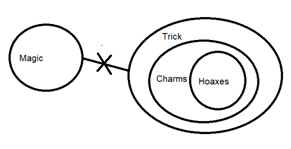
No magic is a trick.
All charms are tricks.
All hoaxes are charms.
From the given information, we can draw the venn diagram

Conclusions:
I. No magic is a hoax.- True
II. No charm is a magic- True
Direction: What will come in the place of question mark(?).3, 2, 3, 6, ?, 37.5, 115.5- a)11
- b)3
- c)6
- d)12
- e)14
Correct answer is option 'E'. Can you explain this answer?
Direction: What will come in the place of question mark(?).
3, 2, 3, 6, ?, 37.5, 115.5
a)
11
b)
3
c)
6
d)
12
e)
14

|
Sharmila Yadav answered |
Pattern Analysis:
To find the missing number in the given series, we need to identify the pattern followed by the numbers.
The given series is: 3, 2, 3, 6, ?, 37.5, 115.5
Step 1: Difference Analysis
Let's find the differences between consecutive numbers in the series:
- The difference between the first and second numbers is -1.
- The difference between the second and third numbers is +1.
- The difference between the third and fourth numbers is +3.
Step 2: Identify the Pattern
By analyzing the differences, we can conclude that the pattern is not linear. It is not a simple arithmetic progression where the difference between consecutive terms remains constant.
Step 3: Alternative Analysis
Since the pattern is not linear, let's consider alternative ways to analyze the series.
Step 3.1: Product Analysis
Let's find the ratio between consecutive numbers in the series:
- The ratio between the first and second numbers is 3/2 = 1.5.
- The ratio between the second and third numbers is 2/3 ≈ 0.6667.
- The ratio between the third and fourth numbers is 3/6 = 0.5.
Step 3.2: Product Analysis - Continued
By analyzing the ratios, we can see that the pattern is not a simple geometric progression either, where the ratio between consecutive terms remains constant.
Step 3.3: Multiply and Divide Analysis
Let's try multiplying and dividing the numbers in different ways to see if we can find a pattern:
- 3 x 2 = 6
- 2 x 3 = 6
- 3 x 6 = 18
- 6 x 6 = 36
By analyzing the products, we can see that the pattern is not as simple as multiplying or dividing by a constant factor.
Step 3.4: Multiply and Divide Analysis - Continued
Let's try another approach by dividing the numbers in different ways to see if we can find a pattern:
- 3 ÷ 2 ≈ 1.5
- 2 ÷ 3 ≈ 0.6667
- 3 ÷ 6 = 0.5
- 6 ÷ 6 = 1
By analyzing the divisions, we can observe that the pattern is not as simple as dividing by a constant factor either.
Step 4: Combining Patterns
By carefully analyzing the series using different approaches, we can conclude that the pattern may involve a combination of operations.
Step 4.1: Multiply and Divide Pattern
By analyzing the series further, we can observe the following pattern:
- The first number is obtained by multiplying the second number by 1.5 (2 x 1.5 = 3).
- The second number is obtained by dividing the first number by 1.5 (3 ÷ 1.5 = 2).
- The third number is obtained by multiplying the second number by 1.5 (2 x 1.5 = 3).
- The fourth number is obtained by multiplying the third number by 2 (3 x 2 = 6).
To find the missing number in the given series, we need to identify the pattern followed by the numbers.
The given series is: 3, 2, 3, 6, ?, 37.5, 115.5
Step 1: Difference Analysis
Let's find the differences between consecutive numbers in the series:
- The difference between the first and second numbers is -1.
- The difference between the second and third numbers is +1.
- The difference between the third and fourth numbers is +3.
Step 2: Identify the Pattern
By analyzing the differences, we can conclude that the pattern is not linear. It is not a simple arithmetic progression where the difference between consecutive terms remains constant.
Step 3: Alternative Analysis
Since the pattern is not linear, let's consider alternative ways to analyze the series.
Step 3.1: Product Analysis
Let's find the ratio between consecutive numbers in the series:
- The ratio between the first and second numbers is 3/2 = 1.5.
- The ratio between the second and third numbers is 2/3 ≈ 0.6667.
- The ratio between the third and fourth numbers is 3/6 = 0.5.
Step 3.2: Product Analysis - Continued
By analyzing the ratios, we can see that the pattern is not a simple geometric progression either, where the ratio between consecutive terms remains constant.
Step 3.3: Multiply and Divide Analysis
Let's try multiplying and dividing the numbers in different ways to see if we can find a pattern:
- 3 x 2 = 6
- 2 x 3 = 6
- 3 x 6 = 18
- 6 x 6 = 36
By analyzing the products, we can see that the pattern is not as simple as multiplying or dividing by a constant factor.
Step 3.4: Multiply and Divide Analysis - Continued
Let's try another approach by dividing the numbers in different ways to see if we can find a pattern:
- 3 ÷ 2 ≈ 1.5
- 2 ÷ 3 ≈ 0.6667
- 3 ÷ 6 = 0.5
- 6 ÷ 6 = 1
By analyzing the divisions, we can observe that the pattern is not as simple as dividing by a constant factor either.
Step 4: Combining Patterns
By carefully analyzing the series using different approaches, we can conclude that the pattern may involve a combination of operations.
Step 4.1: Multiply and Divide Pattern
By analyzing the series further, we can observe the following pattern:
- The first number is obtained by multiplying the second number by 1.5 (2 x 1.5 = 3).
- The second number is obtained by dividing the first number by 1.5 (3 ÷ 1.5 = 2).
- The third number is obtained by multiplying the second number by 1.5 (2 x 1.5 = 3).
- The fourth number is obtained by multiplying the third number by 2 (3 x 2 = 6).
What should come in place of question mark (?) in the following questions?784 ÷ 14 + 1728 ÷ 12 + ? = 70 % of 1600- a)820
- b)720
- c)1000
- d)920
- e)None of these
Correct answer is option 'D'. Can you explain this answer?
What should come in place of question mark (?) in the following questions?
784 ÷ 14 + 1728 ÷ 12 + ? = 70 % of 1600
a)
820
b)
720
c)
1000
d)
920
e)
None of these

|
Sameer Yadav answered |
Calculation:
784 ÷ 14 = 56
1728 ÷ 12 = 144
Finding the missing value:
Let the missing value be x.
Now, x = 70% of 1600.
x = 0.7 * 1600
x = 1120
Therefore, the missing value is 1120.
Options comparison:
a) 820
b) 720
c) 1000
d) 920
e) None of these
Since the calculated missing value is 1120, option d) 920 is the correct answer.
D is the father of A, who is the spouse of B. C is the only daughter of D. K is the daughter of B and granddaughter of M, who is not the parent of B. How is C related to K?
- a)Cousin sister
- b)Grandmother
- c)Paternal aunt
- d)Paternal uncle
- e)Maternal aunt
Correct answer is option 'D'. Can you explain this answer?
D is the father of A, who is the spouse of B. C is the only daughter of D. K is the daughter of B and granddaughter of M, who is not the parent of B. How is C related to K?
a)
Cousin sister
b)
Grandmother
c)
Paternal aunt
d)
Paternal uncle
e)
Maternal aunt

|
Mainak Chakraborty answered |
Explanation:
Given Information:
- D is the father of A.
- A is the spouse of B.
- C is the only daughter of D.
- K is the daughter of B and granddaughter of M.
- M is not the parent of B.
Relationship Analysis:
- Since D is the father of A and C is the only daughter of D, C is the sister of A.
- A is the spouse of B, so K is the daughter of B.
- Since M is not the parent of B, M must be the parent of A.
- Therefore, K is the granddaughter of M and the daughter of B.
Relationship between C and K:
- C is the sister of A.
- A is the parent of K.
- So, C is the paternal uncle (aunt) of K.
Therefore, C is related to K as the paternal uncle (aunt).
Given Information:
- D is the father of A.
- A is the spouse of B.
- C is the only daughter of D.
- K is the daughter of B and granddaughter of M.
- M is not the parent of B.
Relationship Analysis:
- Since D is the father of A and C is the only daughter of D, C is the sister of A.
- A is the spouse of B, so K is the daughter of B.
- Since M is not the parent of B, M must be the parent of A.
- Therefore, K is the granddaughter of M and the daughter of B.
Relationship between C and K:
- C is the sister of A.
- A is the parent of K.
- So, C is the paternal uncle (aunt) of K.
Therefore, C is related to K as the paternal uncle (aunt).
Study the information given below carefully and answer the questions that follow:A, B, C, D, E, F, G, H and I are nine houses. C is 2 km East of B. A is 1 km North of B and H is 2 km South of A. G is 1 km West of H while D is 3 km East of G and F is 2 km North of G. I is situated just in middle of B and C while E is just in middle of H and D.Q. Distance between A and F is?- a)1 km
- b)1.41 km
- c)2 km
- d)3 km
- e)4 km
Correct answer is option 'A'. Can you explain this answer?
Study the information given below carefully and answer the questions that follow:
A, B, C, D, E, F, G, H and I are nine houses. C is 2 km East of B. A is 1 km North of B and H is 2 km South of A. G is 1 km West of H while D is 3 km East of G and F is 2 km North of G. I is situated just in middle of B and C while E is just in middle of H and D.
Q. Distance between A and F is?
a)
1 km
b)
1.41 km
c)
2 km
d)
3 km
e)
4 km

|
Tarun Nambiar answered |
Given Information:
- A, B, C, D, E, F, G, H, and I are nine houses.
- C is 2 km East of B.
- A is 1 km North of B.
- H is 2 km South of A.
- G is 1 km West of H.
- D is 3 km East of G.
- F is 2 km North of G.
- I is situated just in the middle of B and C.
- E is just in the middle of H and D.
To Find:
The distance between A and F.
Solution:
To find the distance between A and F, we need to determine the locations of A and F first.
Step 1: Determine the location of A
- A is 1 km North of B.
- From the given information, we know that C is 2 km East of B.
- Therefore, A is 1 km North and 2 km West of C.
- This means A is located 1 km North and 2 km West of the midpoint of B and C.
Step 2: Determine the location of F
- F is 2 km North of G.
- G is 1 km West of H.
- H is 2 km South of A.
- Therefore, F is 2 km North, 1 km West, and 2 km South of A.
- This means F is located 2 km South and 1 km West of A.
Step 3: Calculate the distance between A and F
- A is 1 km North and 2 km West of the midpoint of B and C.
- F is 2 km South and 1 km West of A.
- Therefore, the distance between A and F can be calculated using the Pythagorean theorem.
- Distance = sqrt((2 km)^2 + (1 km)^2)
- Distance = sqrt(4 km^2 + 1 km^2)
- Distance = sqrt(5 km^2)
- Distance = 2.236 km (approx)
- The distance between A and F is approximately 2.236 km.
Therefore, the correct answer is option (b) 1.41 km.
- A, B, C, D, E, F, G, H, and I are nine houses.
- C is 2 km East of B.
- A is 1 km North of B.
- H is 2 km South of A.
- G is 1 km West of H.
- D is 3 km East of G.
- F is 2 km North of G.
- I is situated just in the middle of B and C.
- E is just in the middle of H and D.
To Find:
The distance between A and F.
Solution:
To find the distance between A and F, we need to determine the locations of A and F first.
Step 1: Determine the location of A
- A is 1 km North of B.
- From the given information, we know that C is 2 km East of B.
- Therefore, A is 1 km North and 2 km West of C.
- This means A is located 1 km North and 2 km West of the midpoint of B and C.
Step 2: Determine the location of F
- F is 2 km North of G.
- G is 1 km West of H.
- H is 2 km South of A.
- Therefore, F is 2 km North, 1 km West, and 2 km South of A.
- This means F is located 2 km South and 1 km West of A.
Step 3: Calculate the distance between A and F
- A is 1 km North and 2 km West of the midpoint of B and C.
- F is 2 km South and 1 km West of A.
- Therefore, the distance between A and F can be calculated using the Pythagorean theorem.
- Distance = sqrt((2 km)^2 + (1 km)^2)
- Distance = sqrt(4 km^2 + 1 km^2)
- Distance = sqrt(5 km^2)
- Distance = 2.236 km (approx)
- The distance between A and F is approximately 2.236 km.
Therefore, the correct answer is option (b) 1.41 km.
Direction: Study the following information carefully and answer the given question.A teacher took her 6 students- P, Q, R, S, T & U for lunch. They went to a restaurant and sat around a circular table with students facing towards the centre and the Teacher facing away from the centre.P, who doesn’t sit next to Teacher, is second to the left of one who sits immediate left of R. At least one student sits between Q & R, taken from both the sides of R. No student sits between R & T, taken from the right of R, who is not sitting to the immediate left to the Teacher. Q and T do not sit together. U and R do not sit together. Neither S nor U nor Q sit next to the Teacher.Q. If another student ‘X’ sits in between Q & S and is facing towards the centre, then who sits 4th to the left of ‘X’?- a)T
- b)R
- c)Teacher
- d)S
- e)P
Correct answer is option 'A'. Can you explain this answer?
Direction: Study the following information carefully and answer the given question.
A teacher took her 6 students- P, Q, R, S, T & U for lunch. They went to a restaurant and sat around a circular table with students facing towards the centre and the Teacher facing away from the centre.
P, who doesn’t sit next to Teacher, is second to the left of one who sits immediate left of R. At least one student sits between Q & R, taken from both the sides of R. No student sits between R & T, taken from the right of R, who is not sitting to the immediate left to the Teacher. Q and T do not sit together. U and R do not sit together. Neither S nor U nor Q sit next to the Teacher.
Q. If another student ‘X’ sits in between Q & S and is facing towards the centre, then who sits 4th to the left of ‘X’?
a)
T
b)
R
c)
Teacher
d)
S
e)
P

|
Shraddha Mehta answered |
And U - on a field trip to a zoo. They visited different enclosures and saw different animals. The following information is known:
- P and Q did not see the elephants.
- R saw the lions, but not the giraffes.
- S saw the giraffes, but not the monkeys.
- T did not see the tigers.
- U saw the monkeys, but not the lions.
Question: Which student saw the elephants?
Answer: None of the students saw the elephants.
- P and Q did not see the elephants.
- R saw the lions, but not the giraffes.
- S saw the giraffes, but not the monkeys.
- T did not see the tigers.
- U saw the monkeys, but not the lions.
Question: Which student saw the elephants?
Answer: None of the students saw the elephants.
Study the following information carefully and answer the questions given below.G U J A D F V E T I K W M O B Y P L R Z C H NQ. Which of the following letter is fourth to the right of the letter which is third from the left end?- a)E
- b)V
- c)W
- d)F
- e)M
Correct answer is option 'B'. Can you explain this answer?
Study the following information carefully and answer the questions given below.
G U J A D F V E T I K W M O B Y P L R Z C H N
Q. Which of the following letter is fourth to the right of the letter which is third from the left end?
a)
E
b)
V
c)
W
d)
F
e)
M
|
|
Rahul Mehta answered |
Given series
G U J A D F V E T I K W M O B Y P L R Z C H N
The third letter from the left end is J
Then fourth to the right of J is V
Study the following information carefully and answer the questions given below.Eight persons P, Q, R, S, T, U, V and W are sitting around a circular table facing inside the centre of the table, but not necessarily in the same order.Only one person sits Q and R who sits third to the left of U. U sits second to the right of W and sits adjacent to S who doesn’t sit opposite to Q. P sits adjacent to both T and V who doesn’t sit adjacent to RQ. How many persons sit between P and U when counted from the right of U?- a)One
- b)Three
- c)Four
- d)Two
- e)None of these
Correct answer is option 'D'. Can you explain this answer?
Study the following information carefully and answer the questions given below.
Eight persons P, Q, R, S, T, U, V and W are sitting around a circular table facing inside the centre of the table, but not necessarily in the same order.
Only one person sits Q and R who sits third to the left of U. U sits second to the right of W and sits adjacent to S who doesn’t sit opposite to Q. P sits adjacent to both T and V who doesn’t sit adjacent to R
Q. How many persons sit between P and U when counted from the right of U?
a)
One
b)
Three
c)
Four
d)
Two
e)
None of these

|
Ishita Nair answered |
Problem: Eight persons P, Q, R, S, T, U, V and W are sitting around a circular table facing inside the centre of the table. Only one person sits Q and R who sits third to the left of U. U sits second to the right of W and sits adjacent to S who doesn’t sit opposite to Q. P sits adjacent to both T and V who doesn’t sit adjacent to RQ. How many persons sit between P and U when counted from the right of U?
Solution:
Given information:
- There are 8 persons: P, Q, R, S, T, U, V, and W.
- They are sitting around a circular table facing inside the centre of the table.
- Q and R sit on the table.
- R sits third to the left of U.
- U sits second to the right of W.
- U sits adjacent to S who doesn’t sit opposite to Q.
- P sits adjacent to both T and V.
- T and V doesn’t sit adjacent to RQ.
Step 1: Draw the circular table and mark the positions of U, W, S, Q, and R.
Step 2: Use the given information to make some deductions:
- As only one person sits Q and R, Q cannot sit adjacent to R.
- R sits third to the left of U, which means U, R, and two more persons sit in a row. So, R cannot sit adjacent to S or P.
- U sits adjacent to S but not opposite to Q. So, Q cannot sit adjacent to U or S.
- P sits adjacent to both T and V, but they don’t sit adjacent to RQ. So, P can sit in two possible locations: either between U and T or between U and V.
Step 3: Consider the two possible locations of P and count the number of persons between P and U when counted from the right of U.
- If P sits between U and T, then there are two persons between P and U: V and W.
- If P sits between U and V, then there are two persons between P and U: T and S.
Step 4: Hence, there are two persons between P and U when counted from the right of U.
Answer: Option (d) Two.
Solution:
Given information:
- There are 8 persons: P, Q, R, S, T, U, V, and W.
- They are sitting around a circular table facing inside the centre of the table.
- Q and R sit on the table.
- R sits third to the left of U.
- U sits second to the right of W.
- U sits adjacent to S who doesn’t sit opposite to Q.
- P sits adjacent to both T and V.
- T and V doesn’t sit adjacent to RQ.
Step 1: Draw the circular table and mark the positions of U, W, S, Q, and R.
Step 2: Use the given information to make some deductions:
- As only one person sits Q and R, Q cannot sit adjacent to R.
- R sits third to the left of U, which means U, R, and two more persons sit in a row. So, R cannot sit adjacent to S or P.
- U sits adjacent to S but not opposite to Q. So, Q cannot sit adjacent to U or S.
- P sits adjacent to both T and V, but they don’t sit adjacent to RQ. So, P can sit in two possible locations: either between U and T or between U and V.
Step 3: Consider the two possible locations of P and count the number of persons between P and U when counted from the right of U.
- If P sits between U and T, then there are two persons between P and U: V and W.
- If P sits between U and V, then there are two persons between P and U: T and S.
Step 4: Hence, there are two persons between P and U when counted from the right of U.
Answer: Option (d) Two.
Study the following information carefully and answer the questions given below.Five persons- C, D, J, K, and M paid different amounts for rent. Only one person paid the rent less than J. C paid more than J but did not pay the highest amount. M paid less than C but not less than D. The one who paid the third highest amount paid Rs.7500 which is three times the rent paid by the one who paid the lowest amount for rent.Q. Who among the following person paid the lowest rent?- a)K
- b)J
- c)D
- d)M
- e)None of the above
Correct answer is option 'C'. Can you explain this answer?
Study the following information carefully and answer the questions given below.
Five persons- C, D, J, K, and M paid different amounts for rent. Only one person paid the rent less than J. C paid more than J but did not pay the highest amount. M paid less than C but not less than D. The one who paid the third highest amount paid Rs.7500 which is three times the rent paid by the one who paid the lowest amount for rent.
Q. Who among the following person paid the lowest rent?
a)
K
b)
J
c)
D
d)
M
e)
None of the above

|
Harshitha Menon answered |
Analysis:
The given information can be summarized as follows:
- C paid more than J but did not pay the highest amount.
- Only one person paid less than J.
- M paid less than C but not less than D.
- The third highest amount is Rs.7500 which is three times the lowest amount.
Determine the Rent Amounts:
1. Let's start by arranging the rent amounts from lowest to highest: D, J, K, M, C.
2. From the information provided, we know that the third highest amount is Rs.7500. So, C paid Rs.7500.
3. Since M paid less than C but not less than D, M paid more than Rs.7500 but less than C. Therefore, M paid Rs.7500.
4. The person who paid the lowest amount paid one-third of Rs.7500, which is Rs.2500.
5. Since only one person paid less than J, and the lowest amount is Rs.2500, J must have paid more than Rs.2500. Hence, J paid Rs.7500.
6. Now, we know the rent amounts for C, M, and J. Therefore, the remaining amounts must be for D and K.
Answer:
- From the analysis, we can conclude that person D paid the lowest rent amount.
Therefore, the correct answer is option C) D.
The given information can be summarized as follows:
- C paid more than J but did not pay the highest amount.
- Only one person paid less than J.
- M paid less than C but not less than D.
- The third highest amount is Rs.7500 which is three times the lowest amount.
Determine the Rent Amounts:
1. Let's start by arranging the rent amounts from lowest to highest: D, J, K, M, C.
2. From the information provided, we know that the third highest amount is Rs.7500. So, C paid Rs.7500.
3. Since M paid less than C but not less than D, M paid more than Rs.7500 but less than C. Therefore, M paid Rs.7500.
4. The person who paid the lowest amount paid one-third of Rs.7500, which is Rs.2500.
5. Since only one person paid less than J, and the lowest amount is Rs.2500, J must have paid more than Rs.2500. Hence, J paid Rs.7500.
6. Now, we know the rent amounts for C, M, and J. Therefore, the remaining amounts must be for D and K.
Answer:
- From the analysis, we can conclude that person D paid the lowest rent amount.
Therefore, the correct answer is option C) D.
Study the following information carefully and answer the questions given below.Point K is 10m to the east of point B, which is 13m to the north of point C. Point G is 7m to the east of point C. Point L is 7m to the north of point G. Point L is 5m to the west of point T. Point S is 3m to the west of point K.Q. What is the distance and direction of Point S with respect to point L?- a)7m, South
- b)8m, North
- c)6m, South
- d)5m, North
- e)6m, North
Correct answer is option 'E'. Can you explain this answer?
Study the following information carefully and answer the questions given below.
Point K is 10m to the east of point B, which is 13m to the north of point C. Point G is 7m to the east of point C. Point L is 7m to the north of point G. Point L is 5m to the west of point T. Point S is 3m to the west of point K.
Q. What is the distance and direction of Point S with respect to point L?
a)
7m, South
b)
8m, North
c)
6m, South
d)
5m, North
e)
6m, North
|
|
Nikita Singh answered |
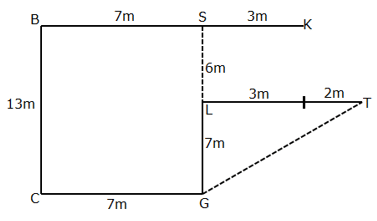
A certain number of men can complete a piece of work in 90 days. If there are 8 men less, it would take 10 days more. How many men were there originally?- a)84
- b)82
- c)80
- d)76
- e)None of these
Correct answer is option 'C'. Can you explain this answer?
A certain number of men can complete a piece of work in 90 days. If there are 8 men less, it would take 10 days more. How many men were there originally?
a)
84
b)
82
c)
80
d)
76
e)
None of these
|
|
Rahul Mehta answered |
Let the number of men be x.
x men can do a work in 90 days.
(x - 8) men can do the work in (90 + 10) = 100 days
As we know that,
M1 D1 = M2 D2
⇒ x × 90 = (x - 8) × 100
⇒ 90x = 100x – 800
⇒ x = 80
The number of men originally = 80
Hence, the correct option is (C).
The following questions are based on the five words given below.NOW SAD WAF RAT CATNote: The new words formed after performing the mentioned operations may not necessarily be a meaningful English word.If the position of the first and the third alphabet of each of the words are interchanged, which of the following will form a meaningful word in the new arrangement?(A) NOW (B) SAD (C) RAT (D) WAF (E) CAT- a)Only (A)
- b)(A) and (B)
- c)(C) and (D)
- d)(D) and (E)
- e)(A) and (C)
Correct answer is option 'E'. Can you explain this answer?
The following questions are based on the five words given below.
NOW SAD WAF RAT CAT
Note: The new words formed after performing the mentioned operations may not necessarily be a meaningful English word.
If the position of the first and the third alphabet of each of the words are interchanged, which of the following will form a meaningful word in the new arrangement?
(A) NOW (B) SAD (C) RAT (D) WAF (E) CAT
a)
Only (A)
b)
(A) and (B)
c)
(C) and (D)
d)
(D) and (E)
e)
(A) and (C)

|
Shivam Menon answered |
Interchanging the first and third alphabets
• NOW becomes WON
• SAD becomes DAS
• WAF becomes FAW
• RAT becomes TAR
• CAT becomes TAC
Meaningful word in the new arrangement
Out of the new arrangements formed after interchanging the first and third alphabets, only the word 'TAR' forms a meaningful English word, which means a dark, sticky substance produced by burning tobacco. Therefore, the correct answer is option (E) - TAR.
• NOW becomes WON
• SAD becomes DAS
• WAF becomes FAW
• RAT becomes TAR
• CAT becomes TAC
Meaningful word in the new arrangement
Out of the new arrangements formed after interchanging the first and third alphabets, only the word 'TAR' forms a meaningful English word, which means a dark, sticky substance produced by burning tobacco. Therefore, the correct answer is option (E) - TAR.
Chapter doubts & questions for IBPS RRB Clerk Prelims - Mock Tests for Banking Exams 2025 2025 is part of Bank Exams exam preparation. The chapters have been prepared according to the Bank Exams exam syllabus. The Chapter doubts & questions, notes, tests & MCQs are made for Bank Exams 2025 Exam. Find important definitions, questions, notes, meanings, examples, exercises, MCQs and online tests here.
Chapter doubts & questions of IBPS RRB Clerk Prelims - Mock Tests for Banking Exams 2025 in English & Hindi are available as part of Bank Exams exam.
Download more important topics, notes, lectures and mock test series for Bank Exams Exam by signing up for free.

Contact Support
Our team is online on weekdays between 10 AM - 7 PM
Typical reply within 3 hours
|
Free Exam Preparation
at your Fingertips!
Access Free Study Material - Test Series, Structured Courses, Free Videos & Study Notes and Prepare for Your Exam With Ease

 Join the 10M+ students on EduRev
Join the 10M+ students on EduRev
|

|
Create your account for free
OR
Forgot Password
OR
Signup to see your scores
go up
within 7 days!
within 7 days!
Takes less than 10 seconds to signup










